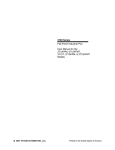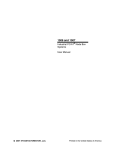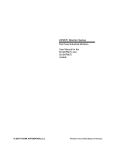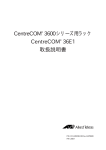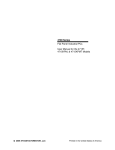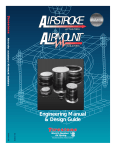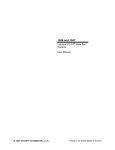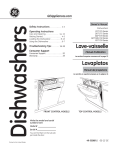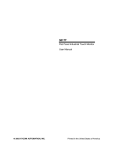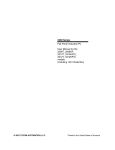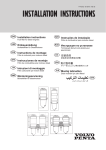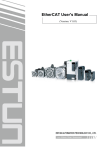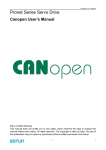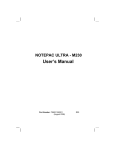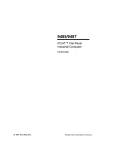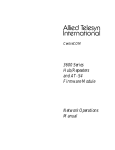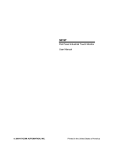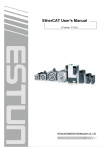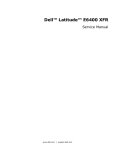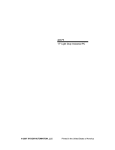Download - Pro
Transcript
3600 Series Flat Panel Industrial PCs User Manual for the 3612T, 3612KPM, 3612KPMT, 3615T, 3615KPM, & 3615KPMT Models 2007 XYCOM AUTOMATION, LLC. Printed in the United States of America 3600 Series Flat Panel Industrial PC Revision A B C D E F G H Revision Record Description Manual Released Manual updated with KPM features Hazardous Locations Control Drawing Added 3615 information Updated touch screen driver installation and calibration / Added TIR caution note / Updated Front Panel table / Updated 3612T frame composition information Updated to add AIM3 Lithiumbattery replacement information Name change, correct where applicable with document Date 7/03 8/03 12/03 2/04 5/04 6/04 8/04 1/06 4/07 Part Number 142214 (H) Trademark Information Xycom and Xycom Automation are trademarks of Xycom Automation, L.L.C. Xycom Automation, L.L.C. now is referred to as Pro-face through a D.B.A. The Pro-face name and logo will replace the Xycom name and logo on all documents where possible. Pro-face is a trademark of Digital Electronics Corporation. Brand or product names are trademarks or registered trademarks of their respective owners. Intel and Pentium are registered trademarks and Celeron is a trademark of Intel Corporation. Windows, Windows NT, and Windows XP are registered trademarks of Microsoft Corporation in the U.S. and in other countries.. Copyright Information This document is copyrighted by Xycom Automation, L.L.C. (Xycom) and shall not be reproduced or copied without expressed written authorization from Xycom Automation, L.L.C. The information contained within this document is subject to change without notice. Pro-face does not guarantee the accuracy of the information. United States FCC Part 15, Subpart B, Class A EMI Compliance Statement: NOTE: This equipment has been tested and found to comply with the limits for a Class A digital device, pursuant to part 15 of the FCC Rules. These limits are designed to provide reasonable protection against harmful interference when the equipment is operated in a commercial environment. This equipment generates, uses, and can radiate radio frequency energy and, if not installed and used in accordance with the instruction manual, may cause harmful interference to radio communications. Operation of this equipment in a residential area is likely to cause harmful interference in which case the user will be required to correct the interference at the user’s expense. For European Users – WARNING: This is a Class A product. In a domestic environment this product may cause radio interference in which case the user may be required to take adequate measures. INSTALLATION – Electromagnetic Compatibility WARNING: The connection of non-shielded equipment interface cables to this equipment will invalidate FCC EMI and European violation of regulations applying to the legal operation of this device. It is the responsibility of the system integrator and/or user to apply the following directions relating to installation and configuration: All interface cables must include shielded cables. Braid/foil type shields are recommended. Communication cable connectors must be metal, ideally zinc die-cast backshell types, and provide 360-degree protection about the interface wires. The cable shield braid must be terminated directly to the metal connector shell; ground drain wires alone are not adequate. Protective measures for power and interface cables as described within this manual must be applied. Do not leave cables connected to unused interfaces or disconnected at one end. Changes or modifications to this device not expressly approved by the manufacturer could void the user’s authority to operate the equipment. EMC compliance is, in part, a function of PCB design. Third party add-on AT/XT peripheral PCB assemblies installed within this apparatus may void EMC compliance. FCC/CE compliant PCB assemblies should always be used where possible. Pro-face can accept no responsibility for the EMC performance of this apparatus after system integrator/user installation of PCB assemblies not manufactured and/or expressly tested and approved for compliance by Pro-face. It is the responsibility of the system integrator/user to ensure that installation and operation of such devices does not void EMC compliance. i 142214 (H) Table of Contents CHAPTER 1 – INTRODUCTION ...........................................................................................................................1 PRODUCT OVERVIEW................................................................................................................................................1 STANDARD FEATURES ..............................................................................................................................................1 OPTIONAL FEATURES................................................................................................................................................3 Front Panels ........................................................................................................................................................4 Back Panel.........................................................................................................................................................10 Power Panel ......................................................................................................................................................11 UNPACKING THE SYSTEM .......................................................................................................................................12 QUICK STARTUP .....................................................................................................................................................12 CHAPTER 2 – INSTALLATION ..........................................................................................................................13 INSTALLATION OVERVIEW ......................................................................................................................................13 SYSTEM CUTOUT DIMENSIONS ...............................................................................................................................15 3612T................................................................................................................................................................15 3612KPM(T).....................................................................................................................................................16 3615T................................................................................................................................................................17 3615KPM(T).....................................................................................................................................................18 POWER MANAGEMENT ...........................................................................................................................................19 System Power.....................................................................................................................................................19 Excessive Heat...................................................................................................................................................20 Electrical Noise .................................................................................................................................................20 Line Voltage Variation ......................................................................................................................................20 AC Power Cable ................................................................................................................................................21 INSTALLING INTERNAL HARDWARE OPTIONS .........................................................................................................22 DRAM and Additional DRAM Dual Inline Memory Modules (DIMMs) ...........................................................23 PC/AT™ and PCI Boards...................................................................................................................................23 USING A TOUCH SCREEN ........................................................................................................................................23 Installing the Touch Screen Driver....................................................................................................................23 Calibrating the Touch Screen............................................................................................................................24 CUSTOM LOGO .......................................................................................................................................................26 CREATING CUSTOM KEYPAD INSERTS ....................................................................................................................26 HAZARDOUS LOCATIONS INSTALLATION ................................................................................................................31 Safety Agency Approval.....................................................................................................................................32 Definitions .........................................................................................................................................................33 Class I Locations ...............................................................................................................................................33 Class II Locations..............................................................................................................................................33 Division 1 Locations..........................................................................................................................................33 Division 2 Locations..........................................................................................................................................34 Groups ...............................................................................................................................................................34 Enclosures .........................................................................................................................................................35 Power Switch .....................................................................................................................................................35 Cable Connections.............................................................................................................................................35 Communication Cable Interfaces ......................................................................................................................36 Hazardous Locations Control Drawing ............................................................................................................37 Operation and Maintenance..............................................................................................................................38 CHAPTER 3 – KEYPAD UTILITY PROGRAM ................................................................................................39 LOADING THE KEYPAD UTILITY ..............................................................................................................................39 USING THE KEYPAD UTILITY ..................................................................................................................................40 STARTUP.................................................................................................................................................................40 ii 142214 (H) 3600 Series Flat Panel Industrial PC Table of Contents MAIN MENU ...........................................................................................................................................................40 Exit.....................................................................................................................................................................41 Files Menu .........................................................................................................................................................41 Macros Menu.....................................................................................................................................................42 Upload Menu .....................................................................................................................................................44 Download Menu ................................................................................................................................................44 Utilities Menu ....................................................................................................................................................45 UTILITY BATCH MODE ...........................................................................................................................................45 KEYPAD SCAN CODES ............................................................................................................................................46 CHAPTER 4 – MAINTENANCE ..........................................................................................................................49 GENERAL PREVENTIVE MAINTENANCE ..................................................................................................................49 Fuse Replacement..............................................................................................................................................49 Fan Filter Replacement .....................................................................................................................................49 RECOMMENDED HARD DRIVE PREVENTIVE MAINTENANCE ...................................................................................50 SYSTEM BATTERY REPLACEMENT ..........................................................................................................................51 PRODUCT REPAIR PROGRAM ..................................................................................................................................54 FRONT PANEL FRAME.............................................................................................................................................56 Chemicals Compatible with 3612T Frame ........................................................................................................56 Chemicals Not Compatible with 3612T Frame .................................................................................................56 Chemicals Compatible with 3612KPM and all 3615 Frames ...........................................................................57 FRONT PANEL OVERLAY ........................................................................................................................................58 Chemicals Compatible with Overlay .................................................................................................................58 Compatible Cleaning Agents for Overlay..........................................................................................................58 Chemicals Not Compatible with Overlay ..........................................................................................................58 CHAPTER 5 TROUBLESHOOTING...................................................................................................................59 DIAGNOSTIC TESTING .............................................................................................................................................59 Create Diagnostic Disk......................................................................................................................................59 Prepare the System ............................................................................................................................................59 RUNNING THE TESTS ..............................................................................................................................................61 MS-DOS Reinstallation ...................................................................................................................................62 Windows 98 Reinstallation .............................................................................................................................62 Windows 2000 Reinstallation .........................................................................................................................63 Windows NT Reinstallation ............................................................................................................................63 Windows XP® Reinstallation ............................................................................................................................63 INSTALLING DRIVERS .............................................................................................................................................64 Video Drivers.....................................................................................................................................................64 Video Expansion ................................................................................................................................................64 Touch Screen Drivers ........................................................................................................................................65 Miscellaneous Drivers .......................................................................................................................................65 APPENDIX A – TECHNICAL SPECIFICATIONS ............................................................................................66 HARDWARE SPECIFICATIONS ..................................................................................................................................66 ENVIRONMENTAL SPECIFICATIONS .........................................................................................................................67 APPENDIX B –BLOCK DIAGRAM AND AIM3 LAYOUT ..............................................................................68 AC BLOCK MODEL.................................................................................................................................................68 AIM3 CPU BOARD LAYOUT ..................................................................................................................................69 APPENDIX C – PINOUTS .....................................................................................................................................70 KEYBOARD PORT CONNECTOR ...............................................................................................................................70 MOUSE PORT CONNECTOR .....................................................................................................................................70 DUAL USB CONNECTOR (USB1) ...........................................................................................................................71 iii 142214 (H) 3600 Series Flat Panel Industrial PC Table of Contents PARALLEL PORT CONNECTOR (LPT1) ....................................................................................................................71 SERIAL PORT CONNECTORS ....................................................................................................................................72 COM1 ....................................................................................................................................................................72 COM2 ....................................................................................................................................................................73 VGA CONNECTOR..................................................................................................................................................73 APPENDIX D – AIM3 CONTROLLER JUMPERS............................................................................................74 APPENDIX E – TSKAM JUMPER AND SWITCH SETTINGS .......................................................................75 TSKAM BOARD 1, PART NUMBER 141438-001 2 .................................................................................................75 TSKAM BOARD 2, PART NUMBER 142430-001/2 .................................................................................................76 iv 142214 (H) Chapter 1 – Introduction Product Overview The 3600 series of flat-panel Industrial PCs combines an Intel® Celeron® or Pentium® III processor with a flat-panel display to offer a powerful, compact package for the factory floor and other harsh environments. These PCs feature an open architecture to meet a wide variety of applications that require both a powerful PC and a durable industrial enclosure. The system integrates a computer card cage, mass storage, display, and power supply in a reliable industrial form factor. The 3612T and 3615T are Industrial PCs with touch screen displays. The 3612KPM and 3615KPM are Industrial PCs with displays, integrated keypads and integrated mouses. The 3612KPMT and 3615KPMT are Industrial PCs with integrated keypads, integrated mouses, and touch screen displays. A 3600 system includes: • A four-slot ISA/PCI backplane, which accommodates - • three ¾ length expansion cards: one PCI, one ISA, & one PCI or ISA one ½ length PCI card. Flat panel display 3612 – 12.1” – 800x600 SVGA (TFT) 3615 – 15” – 1024x768 XGA (TFT) The front panel of the unit is sealed to NEMA TYPE 4/4X/12 (UL 50) and IP65 (IEC 60529) standards and is protected by an impact-resistant shield. The processor board combines all the functions of a complete PC/AT compatible computer on a single industrially hardened circuit board. Refer to the AIM3 CPU manual for more information on processor and hardware features. The system’s modular design allows easy access to expansion boards, switches, power supply, flat-panel display, and disk drives. Standard Features The 3600 unit comes standard with the following: • AIM3 CPU Board • Two serial COM ports, with one configured as RS-232 and one configurable as either RS-232 or RS-485 • Parallel port • VGA port 1 142214 (H) 3600 Series Flat Panel Industrial PC Chapter 1 – Introduction • Intel® Socket 370 Celeron® or Pentium® III options up to 1.26GHz • AGP video controller, 4 MB system video RAM, up to 32 MB available • PCI local-bus IDE controller • Two 168-pin SDRAM DIMMs that support 128, 256, and 512 MB options • Two USB 1.1 ports • 100MHz or 133MHz front side bus depending on the Celeron or Pentium III processor type • Standard Features of a 3600 Unit • Flash BIOS • 6.42" mounting depth (maximum for all 3600 models) • Flat-panel active color TFT display: • 12.1" (800x600) on 3612s • 15" (1024x768) on 3615s Four AT bus expansion slots • One ½ length PCI • One ¾ length ISA • One ¾ length PCI • One ¾ length PCI slot or ISA slot Rear IBM® PS/2® keyboard port and mouse port • Status LEDs • Power • Disk • COM • Input • Fault Floppy drive, rear access • CD-ROM, rear access • Removable 20 GB hard drive, rear access • MS-DOS® operating system • All 3600 front panels meet NEMA 4/4X/12 and IP65 specifications when panelmounted • UL Listed for use in Class I and Class II, Division 2 hazardous locations, Groups A, B, C, D, F, and G • • • 2 142214 (H) 3600 Series Flat Panel Industrial PC Chapter 1 – Introduction Additional standard features 3612KPM(T) & 3615KPM(T) models • 40 relegendable function keys (80 with the F/A function) • Numeric, PC control, and alpha keypads • Windows start menu and pop-up menu keys • Integrated mouse • Nonincendive front panel USB and PS/2 keyboard/mouse ports Optional Features Following are optional available features: • Touch screen resistive technology • Higher capacity IDE hard drives and solid state drives • Various processor speeds • Preinstalled Microsoft® Windows® 98, or Windows NT®, or Windows® 2000, or Windows XP® Professional • Compact Flash • 2.5” Dual Hard Drive • 9000-USBF, USB floppy (requires Windows 98, 2000, or XP) • 9000-USBFKA, front access NEMA-sealed USB floppy and keyboard port (requires Windows 98, 2000, or XP) • 9000-RF1, 19” Rack Mount Adapter Plate (for 3612T) • 9000-XBAY (requires an XBAY connector) • 9000-CAP-3612KPM/9487 Adapter Plate (for 3612KPM) to mount in a 9487 or 9450 cutout 3 142214 (H) 3600 Series Flat Panel Industrial PC Chapter 1 – Introduction Front Panels The 3600 series has a NEMA 4/4X/12 and IP65 sealed front panel. The panel protects the system’s interior when the system is properly panel-mounted. 3612T & 3615T Front Panel Figure 1-1. 3612T Front Panel 4 142214 (H) 3600 Series Flat Panel Industrial PC Chapter 1 – Introduction Table 1-1. 3612/15T Front Panel Feature Description Front Panel The front panel has four components: a display; strengthened glass covering the display; a frame in which the display and the glass are mounted; and the polyester overlay attached to both the glass and the frame. The 3612T has a 12.1" TFT LCD flat panel. The 3615T has a 15" TFT LCD flat panel. The strengthened glass covering the display is intended to withstand normal operating conditions. In the event of damage to the glass, the overlay will protect the user from any glass shards. For more information abut the frame or the overlay, see Chapter 5 – Troubleshooting. Diagnostic LEDs Following is a description of the LEDs and their meanings: Power GREEN when the system has power. Disk GREEN when the computer is accessing the disk drive. COM GREEN when there is communication activity on one of the serial ports. Input GREEN when the unit has a touch screen (LED gets brighter when a touch input is detected) or a key is pressed. Fault YELLOW when a configuration error exists. During power-up, the BIOS checks the hardware configuration against the configuration stored in the CMOS memory. Brightness Adjustment These buttons adjust the brightness of the backlights. The right button increases the brightness and the left button decreases the brightness. 5 142214 (H) 3600 Series Flat Panel Industrial PC Chapter 1 – Introduction 3612KPM(T) & 3615KPM(T) Front Panel Diagnostic LEDs Brightness Keyboard/mouse and USB ports Mouse Figure 1-2. 3612KPM(T) Front Panel The 3612KPM(T) features function keys on either side of the flat panel display (PF1-PF20), function keys below the display (F1-F20), a numeric keypad, window keys, a cursor control keypad, diagnostic LEDs, industrial mouse/keyboard and USB ports. All keypad keys are reprogrammable1, except the F/A key, and all function keys are relegendable2. See Chapter 3 for more details. 1 All keypad keys can be programmed to perform any function necessary. 2 You are able to create your own, custom keypad inserts to reflect any reprogramming you may have done. 6 142214 (H) 3600 Series Flat Panel Industrial PC Chapter 1 – Introduction Table 1-2. 3612/15KPM(T) Front Panel Feature Description Front Panel The front panel has four components: a display; strengthened glass covering the display; a frame in which the display and the glass are mounted; and the polyester overlay attached to both the glass and the frame. The 3612KPM(T) has a 12.1" TFT LCD flat panel. The 3615KPM(T) has a 15" TFT LCD flat panel. The strengthened glass covering the display is intended to withstand normal operating conditions. In the event of damage to the glass, the overlay will protect the user from any glass shards. For more information abut the frame or the overlay, see Chapter 5 – Troubleshooting. Diagnostic LEDs Following is a description of the LEDs and their meanings: Power GREEN when the system has power. Disk GREEN when the computer is accessing the disk drive. COM GREEN when there is communication activity on one of the serial ports. Input GREEN when the unit has a touch screen (LED gets brighter when a touch input is detected) or a key is pressed. Fault YELLOW when a configuration error exists. During power-up, the BIOS checks the hardware configuration against the configuration stored in the CMOS memory. Port Access The 3600KPM(T) features front panel access to a PS/2 keyboard/mouse port and a USB 1.1 port. These front access connections on the 3612KPM(T) and 3615KPM(T) are nonincendive circuits and may be used safely in Class I Division 2, Groups A, B, C, & D and in Class II Division 2, Groups F & G applications. Please refer to the Hazardous Locations control drawing on page 37. 74-Key Keypad The 3600KPM(T) keypad features: • Alpha numeric and control keys • 40 relegendable function keys • All keys re-programmable Integrated Mouse The 3612KPM(T) & 3615KPM(T) feature a 2-button integrated mouse. Brightness Adjustment These buttons adjust the brightness of the backlights. The right button increases the brightness and the left button decreases the brightness. See Chapter 3, Keypad Utility, for detailed instructions on programming the keypad. 7 142214 (H) 3600 Series Flat Panel Industrial PC Chapter 1 – Introduction I/O Panel Figure 1-3. 3600 System I/O Panel 8 142214 (H) 3600 Series Flat Panel Industrial PC Chapter 1 – Introduction Table 1-3. 3600 System I/O Panel Feature Description Parallel Port The parallel printer port (LPT1) is a DB-25 pin female connector. This port provides a standard PC-compatible printer interface. COM Ports COM1 is RS-232/485 compatible. RS/232 is connected to the lower 9-pin stacked DB connector. The top part of this stack is the RS/485 version of the same port. Since these connectors are attached to the same port, only one can be used at a time. COM2 is the male 25-pin DB connector. An external push-button reset option and alarm feature is available. Consult the AIM3 CPU manual for the BIOS setting that controls this option. Keyboard Port The keyboard port is a PS/2 stacked mini-DIN so a PC/AT keyboard can be attached at the side of the unit. The keyboard port on the side of the unit is the lower connector. ® Warning: To maintain a safe condition, do not use an external keyboard and/or mouse port when the unit is operating in a hazardous environment. Mouse Port The mouse port is a PS/2 stacked mini-DIN that allows you to attach a mouse at the side of the unit. Warning: To maintain a safe condition, do not use an external keyboard and/or mouse port when the unit is operating in a hazardous environment. Video Port The video port is a 15-pin D-sub VGA connector at the side of the unit. This connector supports any standard VGA connection. Both the LCD flat panel and video port are active as a default at boot time if video display devices are connected to them. USB The Universal Serial Bus (USB) is a double-high connector on-board with a USB port to the off-board connector. Ethernet Port The Ethernet port is an on-board 10/100BASET RJ-45 connector with LEDs. Removable CompactFlash™ access (optional)* This option allows external access to Type I or Type II CompactFlash™ for solid state storage media. 9000-XBAY connector port (optional)* The 9000-XBAY connector port is a factory-installed option that provides a connection from the 3600 to any two IDE devices used by the optional 9000-XBAY. Note: This feature cannot be used if the removable CompactFlash™ option was not ordered. Note: This feature cannot be used if the 9000-XBAY option was not ordered. * This port can be used for the removable CompactFlash™ or the external bay connector but not both. If the user chooses one of these options, it must be factory installed. 9 142214 (H) 3600 Series Flat Panel Industrial PC Chapter 1 – Introduction Back Panel Hard drive access CD-ROM drive Floppy drive Power connector and bracket Figure 1-4. 3600 System Back Panel 10 142214 (H) 3600 Series Flat Panel Industrial PC Chapter 1 – Introduction Power Panel Power Connector Voltage Selector Switch (under retaining bracket) Fan & Filter Figure 1-5. 3600 Side Panel with Fan Filter and Power Connector Table 1-4. 3600 Power Panel Feature Description Power Connector This is a three-pin connector. Refer to the special Hazardous Locations Installation instructions later in this chapter. Product ID Label The product ID label is located on the bottom panel. Fan and Filter The filter can be replaced or removed for cleaning. See Chapter 4 for details on the fan filter assembly. Voltage Selector Switch This switch sets the voltage to 115 or 230 VAC for a 50-60 Hz outlet. 11 142214 (H) 3600 Series Flat Panel Industrial PC Chapter 1 – Introduction Unpacking the System When you remove the system from its shipping container, verify that you have the parts listed below. Save the box and inner wrapping in the event you need to reship the unit. • 3600 series computer • Documentation kit, which includes: • • • • • Power connector 10-32 hex nuts (for panel mounting with the studs) Cable clamp and screw (for strain-relief of power cord) Documentation and Support Library CD-ROM Operating System Recovery Media or operating system installation disk (CD-ROM) Quick Startup This section gives you the steps to get the system up and running without explaining the capabilities and options. Warning Remove power from the unit and disconnect the power cord before making any adjustments to the inside or outside of the computer. Warning For Hazardous Locations installation, review “Hazardous Locations Installation” in Chapter 2 before startup. To prepare the system for use, perform the following steps. 1. Attach optional keyboard to the keyboard port. 2. Attach other optional equipment following the instructions in Chapter 2. 3. Check the 115/230 VAC selector switch on the power supply to see it is set appropriately. 4. Attach the power cord from the power receptacle to a properly grounded 115/230 VAC, 50-60 Hz outlet. (See Chapter 3, Creating a Power Cable.) 5. Turn on power to the unit (via an outlet power switch, if applicable). The system will boot-up into the operating system. 6. Install application software via the floppy, the CD-ROM, or the network. 12 142214 (H) Chapter 2 – Installation This chapter offers detailed installation instructions and outlines the options for the 3600 units. It also includes the guidelines for preparing your unit for installation and use. Installation Overview Warning For Hazardous Locations installation, review the Hazardous Locations Installation section in this chapter before startup. The rugged design of the 3600 unit allows it to be installed in most industrial environments. The system is generally placed in a NEMA 4/4X/12 enclosure to protect against contaminants such as dust, and moisture. Metal enclosures also help minimize the effects of electromagnetic radiation that nearby equipment can generate. Read the following sections carefully to be sure that you are complying with all the safety requirements. 1. Select a NEMA rated enclosure and place the unit to allow easy access to the system ports (see other sections in this chapter and Appendix A). • • To assure a NEMA 4 seal, choose an approved enclosure that has a 14-gauge (0.075 in/1.9 mm thick steel or 0.125 in/3.2 mm thick aluminum) front face. Be sure to account for the unit’s depth when choosing the depth of the enclosure. 2. Create a cutout in the enclosure (see Figure 2-1, Figure 2-2, Figure 2-3, and Figure 2-4 in System Cutout Dimensions). • • Be sure to place the unit at a comfortable working level Make sure the area around the cutout is clean and free from metal burrs 3. Mount the unit in an upright position and properly secure the unit into the panel. • Tighten the fourteen #10 nuts to 25 inch-pounds (2.8 Newton-meters / 28Kgf cm). 4. Construct a power cable following the instructions in AC Power Cable in this chapter. 13 142214 (H) 3600 Series Flat Panel Industrial PC Chapter 2 – Installation 5. Attach one end of the power cord to the power receptacle on the unit and the other end to a properly grounded 115/230 VAC, 50-60 Hz outlet. 6. Turn on power to the system. The system will boot-up the installed operating system. 7. Install the application software via a floppy drive, CD-ROM, or the network. Additional aspects to take into account when mounting your 3600 unit: • Consider locations of accessories such as AC power outlets and lighting (interior illumination and windows) for installation and maintenance convenience • Prevent condensation by installing a thermostat-controlled heater or air conditioner • To allow for maximum cooling, avoid obstructing the airflow • Place any fans or blowers close to the heat generating devices. If using a fan, make sure that outside air is not brought into the enclosure unless a fabric or other reliable filter is used. This filtration prevents conductive particles and other harmful contaminants from entering the enclosure. • Do not select a location near equipment that generates excessive electromagnetic interference (EMI) or radio frequency interference (RFI). Examples of these types of equipment are: high power welding machines; induction heating equipment; and large motor starters. • Place incoming power line devices (such as isolation or constant voltage transformers, local power disconnects, and surge suppressers) away from the system. The proper location of incoming line devices keeps power wire runs as short as possible and minimizes electrical noise transmitted to the unit. • Make sure the location does not exceed the unit’s shock, vibration, and temperature specifications • Install the unit in the rack or panel in such a way as to ensure that it does not cause a hazard from uneven mechanical loading • Incorporate a readily-accessible disconnect device in the fixed wiring on permanently connected equipment • Avoid circuit overloading of the supply circuit 14 142214 (H) 3600 Series Flat Panel Industrial PC Chapter 2 – Installation System Cutout Dimensions 3612T Figure 2-1. 3612T System Cutout Dimensions (inches [mm]) 15 142214 (H) 3600 Series Flat Panel Industrial PC Chapter 2 – Installation 3612KPM(T) Figure 2-2. 3612KPM(T) System Cutout Dimensions (inches [mm]) 16 142214 (H) 3600 Series Flat Panel Industrial PC Chapter 2 – Installation 3615T Figure 2-3. 3615T System Cutout Dimensions (inches [mm]) 17 142214 (H) 3600 Series Flat Panel Industrial PC Chapter 2 – Installation 3615KPM(T) Figure 2-4. 3615KPM(T) System Cutout Dimensions (inches [mm]) 18 142214 (H) 3600 Series Flat Panel Industrial PC Chapter 2 – Installation Power Management The following paragraphs explain the system power, the power supply, and the effects of excessive heat, electrical noise, and line voltage variation of the 3600 unit. System Power Using isolation transformers on the incoming AC power line to the system is always a good practice. An isolation transformer is especially desirable in cases in which heavy equipment is likely to introduce noise onto the AC line. The isolation transformer can also serve as a step-down transformer to reduce the incoming line voltage to a desired level. The transformer should have a sufficient power rating (units of volt-amperes) to supply the load adequately. Proper grounding is essential to all safe electrical installations. Refer to the relevant Federal, State/Provincial, and local electric codes, which provide data as to the size and types of conductors, color codes and connections necessary for safe grounding of electrical components. The code specifies that a grounding path must be permanent (no solder), continuous, and able to safely conduct the ground-fault current in the system with minimal impedance (minimum wire required is #18 AWG, 1 mm). Observe the following practices: • Separate ground wires (P.E. or Protective Earth) from power wires at the point of entry to the enclosure. To minimize the ground wire length within the enclosure, locate the ground reference point near the point of entry for the plant power supply. • All electrical racks or chassis and machine elements should be Earth Grounded in installations where high levels of electrical noise can be expected. The rack/chassis should be grounded with a ground rod or attached to nearby Earth structure such as a steel support beam. Each different apparatus should be connected to a single Earth Ground point in a “star” configuration with low impedance cable. Scrape away paint and other non-conductive material from the area where a chassis makes contact with the enclosure. • In addition to the ground connection made through the mounting bolt or stud, use a one-inch metal braid or size #8 AWG wire to connect between each chassis and the enclosure at the mounting bolt or stud. Power Supply The power supply on 3612 models provides 90 watts of output power throughout the system’s temperature range. The power supply on 3615 models provides 150 watts of output power throughout the system’s temperature range. The power available for expansion is limited as shown in Table 2-1. 19 142214 (H) 3600 Series Flat Panel Industrial PC Chapter 2 – Installation Table 2-1. Available Expansion Current Maximum Available Current Voltage 3612 models 3615 models +3.3 VDC 1.58A 4.95A +5.0 VDC 3.40A 1.92A -5.0 VDC 160mA 190mA +12.0 VDC 0.58A 1.9A -12.0 VDC 160mA 190mA Caution: Caution: +5V and +3.3V not to exceed 17 watts total. +5V and +3.3V not to exceed 26 watts total. –5V and –12V not to exceed 2 watts total. –5V and –12V not to exceed 3.6 watts total. Excessive Heat The units withstand temperatures from 0º to 50ºC, and are fan-cooled. To keep the temperature in range, the cooling air of the system must not exceed 50°C. Allocate proper spacing between internal components installed in the enclosure. Units with standard BIOS release 1.3 or greater will automatically throttle down the CPU speed if the temperature exceeds the maximum allowed CPU temperature. Electrical Noise Electrical noise is seldom responsible for damaging components, unless extremely high energy or high voltage levels are present. However, noise can cause temporary malfunctions, which can result in hazardous machine operation in certain applications. Noise may be present only at certain times, may appear at widespread intervals, or in some cases may exist continuously. Noise commonly enters through input, output, and power supply lines and may also be coupled through the capacitance between these lines and noise signal carrier lines. This usually results from the presence of high voltage or long, closespaced conductors. When control lines are closely spaced with lines carrying large currents, the coupling of magnetic fields can also occur. Use shielded cables to help minimize noise. Potential noise generators include switching components, relays, solenoids, motors, and motor starters. Refer to the relevant Federal, State/Provincial, and local electric codes, which provide data such as the size and types of conductors, color codes and connections necessary for safe grounding of electrical components. It is recommended that the high voltage and low voltage cabling be separated and dressed apart. In particular, the AC cables and switch wiring should not be in the same conduit with all communication cables. Line Voltage Variation The unit’s power supply is built to operate with input voltage ranges of 100-132 VAC and 200-240 VAC, while still allowing the system to function within its operating margin. As long as the incoming voltage is adequate, the power supply provides all the logic voltages necessary to support the processor, memory, and I/O. 20 142214 (H) 3600 Series Flat Panel Industrial PC Chapter 2 – Installation In cases in which the installation is subject to unusual AC line variations, use a constant voltage transformer to prevent the system from shutting down too often. However, a first step toward the solution of the line variations is to correct any possible feed problem in the distribution system. If this correction does not solve the problem, use a constant voltage transformer. The constant voltage transformer stabilizes the input voltage to the 3600 unit by compensating for voltage changes at the primary in order to maintain a steady voltage at the secondary. When using a constant voltage transformer, check that the power rating is sufficient to supply the unit. AC Power Cable A power cable must be created to supply power to the unit. The following materials are needed: • A three-position power connector (supplied) • A braid/foil shielded power cable, terminated at power source end, with three #18 (1.0 mm), #16 (1.3 mm), or #14 (1.6 mm) AWG solid or stranded copper wires, rated 80ºC or better Figure 2-5. 3600 AC Power Connector. Perform the following steps to construct and attach the cable: 1. Cut wire cable to the desired length. 2. Strip 0.25-inch (6 mm) of insulation from the end of the conductor wire. No bare wire should be exposed when the cable is connected to the workstation. 3. Tin the wire ends with solder if using stranded wire. This will keep the wire from fraying. Warning When inserting the wire ends of the power cable into the block plug, be sure there is no exposed wire. Trim the wire ends of the cable or cut a new cable if necessary. 21 142214 (H) 3600 Series Flat Panel Industrial PC Chapter 2 – Installation Figure 2-6. Internal View of a 3600 AC Power Connector 4. Insert the three wire ends of the power cable into the hole of the connector plug. Bend the Protective Earth ground (PE) wire, the neutral (N) wire, and the line (L) wire around the corresponding screw. Be sure that no bare wires are exposed. 5. Tighten the three screws above the wires to hold them firmly in place. Warning Never tighten the three screws of the block plug when the cable is connected to a power source. The screws are conductive and have full contact with the cable wire. 6. Use the screw provided to secure and strain-relief the power cable inside the connector. Plug the power cable into the power supply located on the side of the unit. Install the plug retainer bracket over the plug (mandatory for Hazardous Location installations). 7. Once the power cable and other optional interface cables are installed, the installation is complete. Note When disconnecting the power cord from the unit, be sure to completely loosen the two securing screws on the retainer bracket. Installing Internal Hardware Options Remove the lid to install internal hardware options. Caution Turn off the unit before installing internal hardware. Warning Installation of expansion boards may void safety and/or EMC compliance. 22 142214 (H) 3600 Series Flat Panel Industrial PC Chapter 2 – Installation DRAM and Additional DRAM Dual Inline Memory Modules (DIMMs) You can order the 3600 system CPU factory-configured for many configurations of DRAM. The system has two 168-pin SDRAM DIMMs that support 128, 256, and 512 MB options. The maximum amount supported is 512MB. You can reconfigure the DRAM capacity by changing the DRAM DIMMs on your board. For more information, refer to the AIM3 CPU manual. PC/AT™ and PCI Boards 1. Check that the memory and I/O configuration of the board you want to install does not conflict with the CPU and I/O memory maps in your AIM3 CPU board manual. 2. Remove the lid. 3. Remove the screw attaching the plate to the frame from the desired slot. 4. Slide the PC/AT expansion board into the corresponding rail. 5. Push the board into the backplane connectors. Caution DO NOT force the boards or apply uneven pressure. 6. Secure the board by installing the screw through the hole in the board’s metal plate and into the top of the track. 7. Replace the lid. Using a Touch Screen Pro-face/Xycom’s touch screen complies with environmental specifications and maintains a NEMA 4 seal when panel-mounted. The touch screen Monitor Mouse driver emulates a Microsoft PS/2 mouse. Installing the Touch Screen Driver In order to use the touch screen on your KPMT monitor, you must install the proper driver on the computer hooked to your monitor. For computers running Windows® 98, NT, 2000, or XP, you will be installing the driver touchbase_windows_kpmt_mons.exe. This driver can be found in the “Drivers\Touchscreen” folder on the Documentation and Support Library CD that shipped with your monitor. The default setting is serial mode. 1. Create a folder named “Touch” on your desktop or in the root directory of your C: drive, and unzip the files into the folder. 2. Click on the file “setup.exe” and follow the directions. Pro-face suggests that you accept all of the defaults. 3. Calibrate the touchscreen, following the directions in the next section. 23 142214 (H) 3600 Series Flat Panel Industrial PC Chapter 2 – Installation Caution When using MS-DOS®, the mouse driver must be loaded before the touch screen driver if both a mouse and touch screen are to be supported. For computers running MS-DOS®, you will be installing the driver, touchbase_dos.zip. This driver can be found in the “Drivers\Touchscreen” folder on the Documentation and Support Library CD that shipped with your monitor. 1. Create a directory named “Touch” in the root directory of your C:\ drive and unzip the files into the folder. 2. Run the file “install.exe” in the TB458 subdirectory and follow the directions. Pro-face suggests that you accept all of the defaults. 3. Copy all of the batchfile utilities from the Batch Files subdirectory to C:\ 4. Add the command allser.bat to your autoexec.bat file. 5. Re-boot your system. 6. Calibrate the touchscreen, following the directions in the next section. Caution It is recommended that you keep all default setting when installing the driver. The touch screen drivers are located on the Document and Support Library CD, which is shipped with you unit. Drivers can also be downloaded from http://www.profaceamerica.com. Calibrating the Touch Screen You need to calibrate the touch screen in the following cases: • • The cursor does not follow the movement of your finger or pen. You adjust the size of the video image or change the video mode. For computers running Windows® 98, NT, 2000, or XP: Before calibrating your touch screen, Pro-face strongly recommends altering the following default settings in the calibration program. 1. Go to START/PROGRAMS/UPDD/SETTINGS 2. Click on the Calibration tab. 3. Set the Calibration points to 25. 4. Set the Margin Percentage to 1. Note If the Margin Percentage is set to 0, the calibration may not be correct at the edges of the screen, causing the cursor to jump unexpectedly. 24 142214 (H) 3600 Series Flat Panel Industrial PC Chapter 2 – Installation 5. Click on the Settings tab. 6. Set the Averaging to 0. 7. Click Apply. You are now ready to calibrate your touch screen. Follow the instructions found in the following applet to calibrate the touch screen: START/PROGRAMS/UPDD/CALIBRATE Note The touch screen and controller is a matched pair calibrated at the factory. If touch screen and controllers are interchanged calibration may be needed. For computers running MS-DOS®, the touch screen drivers must be loaded before you can calibrate. After the drivers are loaded, switch to C:\Touch, and run TBCAL.EXE to calibrate the touch screen: 1. Enter the "H" command for hard calibrate 2. Touch the cross hairs as directed by the calibrate utility 3. Save the settings 4. Exit the calibrate utility with the "X" command 25 142214 (H) 3600 Series Flat Panel Industrial PC Chapter 2 – Installation Custom Logo You have the option to place a custom label on the unit. Refer to Figure 2-7 for the dimensions and recommended requirements for a customized label. Once a customized label is procured, place the new label over the “Pro-face/Xycom” label. Figure 2-7. Logo Label Dimensions Creating Custom Keypad Inserts You can customize your keypad with keypad inserts. Refer to Figure 2-8 and Figure 2-9 for insert dimensions and installation for the 3612KPM(T). Refer to Figure 2-10 and Figure 2-11 for insert dimensions and installation for the 3615KPM(T). 26 142214 (H) 3600 Series Flat Panel Industrial PC Chapter 2 – Installation Figure 2-8. 3612 KPM(T) Keypad Inserts with Dimensions (PF1 – PF10) Note: The PF11-PF20 insert has the same dimensions 27 142214 (H) 3600 Series Flat Panel Industrial PC Chapter 2 – Installation Figure 2-9. 3612 KPM(T) Keypad Insert with Dimensions (F1 - F20) 28 142214 (H) 3600 Series Flat Panel Industrial PC Chapter 2 – Installation Figure 2-10. 3615KPM(T) Keypad Inserts with Dimensions (PF1 – PF10) Note: The PF11-PF20 insert has the same dimensions 29 142214 (H) 3600 Series Flat Panel Industrial PC Chapter 2 – Installation Figure 2-11. 3615 KPM(T) Keypad Insert with Dimensions (F1 - F20) 30 142214 (H) 3600 Series Flat Panel Industrial PC Chapter 2 – Installation Hazardous Locations Installation Pro-face/Xycom designed the 3600 series to meet the requirements of Class I and II, Division 2 Hazardous Locations applications. Division 2 locations are those locations that are normally non-hazardous, but could become hazardous due to accidents that may expose the area to flammable vapors, gases or combustible dusts. These systems have been designed as non-incendiary devices. They are not intrinsically safe and should never be operated within a Division 1 (normally hazardous) location when installed as described here. Nor should any peripheral interface device attached to these systems be located within Division 1 locations unless approved and/or certified diode barriers are placed in series with each individual signal and DC power line. Any such installations are beyond the bounds of Pro-face/Xycom design intent. Pro-face accepts no responsibility for installations of this equipment or any devices attached to this equipment in Division 1 locations. Note When additional cards are added, it is the customer’s responsibility to ensure that the cards chosen meet operating conditions for Class I and II, Division 2 Hazardous Locations. Additions and/or modifications without express consent from UL and/or Pro-face will void Hazardous Locations compliance. It is the responsibility of the customer to ensure that the product is properly rated for the location in which it is to be installed. If the intended location does not presently have a Class, Division, and Group rating, then users should consult the appropriate authorities having jurisdiction in order to determine the correct rating for that Hazardous Location. In accordance with Federal, State/Provincial, and Local regulations, all Hazardous Locations installations should be inspected by the appropriate authority having jurisdiction prior to use. Only technically qualified personnel should install, service, and inspect these systems. Warning In order to maintain a safe condition, do not attach an external keyboard or mouse to the rear ports when the unit is operating in a hazardous environment. Refer to the control drawing on page 37 for information on the front USB and keyboard ports. 31 142214 (H) 3600 Series Flat Panel Industrial PC Chapter 2 – Installation Safety Agency Approval The Pro-face/Xycom systems have the following approvals: • Underwriters Laboratories Inc., UL 1604 Standard for Safety. Electrical equipment for use in Class I and Class II, Division 2, and Class III hazardous (classified) locations. (UL Listed, File E180970) • Underwriters Laboratories Inc., UL 508, “Industrial Control Equipment.” (UL Listed, File E107636) • Canadian Standard Association, Specification C22.2 No. 213-M1987. Nonincendiary electrical equipment for use in Class I, Division 2 hazardous locations. (cUL Listed, File E180970) • Canadian Standards Association, Specification C22.2 No. 142, (cUL Listed, File E107636). Warning Suitable for use in Class I, Division 2, Groups A, B, C, and D, and Class II, Division 2, Groups F and G Hazardous Locations or non-hazardous locations only. Warning – Explosion Hazard Substitution of components may impair suitability for Class I, Class II, Division 2. Avertissement – Risque d’Explosion La substitution de composants peut rendre ce materiel inacceptable pour les emplamements de classe I, II, Division 2. Warning – Explosion Hazard Do not disconnect equipment unless the power has been switched off or the area is known to be non-hazardous. Avertissement – Risque d’Explosion Avant de deconnecter l’equipment, coupler le courant ou s’assurer que l’emplacement est designe non dangereux. 32 142214 (H) 3600 Series Flat Panel Industrial PC Chapter 2 – Installation Warning – Explosion Hazard When in Hazardous Locations, turn off power before replacing or wiring modules. Avertissement – Risque d’Explosion Dans les situations hasardees, couper la courant avant de remplacer ou de cabler les modules. Definitions The following Class and Division explanations are derived from Article 500 (Sections 5 and 6) of the United States National Fire Protection Agency National Electric Code (NFPA 70, 1990). They are not complete and are included here only for a general description for those not familiar with generic hazardous locations' requirements. Persons responsible for the installation of this equipment in Hazardous Locations are responsible for ensuring that all relevant codes and regulations related to location rating, enclosure, and wiring are met. Class I Locations Class I locations are those in which flammable gases or vapors are or may be present in the air in quantities sufficient to produce explosive or ignitable mixtures. Class II Locations Class II locations are those that are, or may become, hazardous because of the presence of combustible dust. Division 1 Locations A Division 1 location is one in which flammable or ignitable gasses, vapors, or combustible dusts and particles can exist due the following conditions: • Normal operating conditions; • Because of repair, maintenance conditions, leakage, or mechanical failure or abnormal operation of machinery or equipment; or • Combustible dusts of an electrically conductive nature may be present in hazardous quantities. Note Pro-face systems are not suitable for installation within Division 1 locations. 33 142214 (H) 3600 Series Flat Panel Industrial PC Chapter 2 – Installation Note Electrical equipment cannot be installed in Division 1 locations unless they are intrinsically safe, installed inside approved explosion-proof enclosures, or installed inside approved purged and pressurized enclosures. Division 2 Locations Division 2 locations are listed below: • Class I volatile flammable liquids or flammable gasses are handled, processed, or used, but confined within closed containers or closed systems from which they can escape only in cases of accidental rupture or breakdown of such enclosures or systems, or in case of abnormal operation of equipment. • Ignitable concentrations of Class I vapors or gasses are normally prevented by positive mechanical ventilation, but which may become hazardous due to mechanical failure of those ventilation systems. • Location is adjacent to a Division 1 location. • Class II combustible dust is not normally in the air in quantities sufficient to produce explosive or ignitable mixtures. Dust accumulations are normally insufficient to interfere with normal operation of electrical equipment or other apparatus. Combustible dust may be in suspension in the air as a result of the following: malfunctioning of handling or processing equipment; combustible dust accumulations on, or in the vicinity of electrical equipment; may be ignitable by abnormal operation or failure of electrical equipment. Groups All electrical equipment that is approved for use in Hazardous Locations must include a group rating. Various flammable and combustible substances are divided into these groups as a function of their individual maximum experimental safe gap (MESG), explosion pressure, and ignition temperature. Component temperatures and the potential for spark based upon voltage, current, and circuit characteristics, within electrical equipment, will determine what the equipment group rating will be. A device approved for installation within Class I, Group A locations may also be used in Groups B, C, or D. Note Approved Class I equipment may not be suitable for Class II installations. Class I includes Groups A, B, C, and D. Class II includes Groups F, and G. 34 142214 (H) 3600 Series Flat Panel Industrial PC Chapter 2 – Installation Enclosures The systems are designed for installation within a clean and dry enclosure for both ordinary and hazardous locations. The front panel meets the requirements of UL and CSA Type 4, 4X, and 12 enclosures. The enclosure used for Class I Hazardous Locations should have a minimum rating of Type 12 (NEMA 12, IP 5X). However, Type 4 (IP 6X) enclosures are strongly recommended. Panel flatness and rigidity are important if a proper panel seal is to be maintained. If non-metal type enclosures, such as plastic or fiberglass, are to be used, install a rigid metal stiffener behind the front panel. Failure to do so may result in an inadequate panel seal due to flexure of the front panel material between the stud mounts. Tighten the nuts on the mounting studs to 25 inch-pounds. The requirements for enclosure fittings, conduit, and wiring vary according to the specific rating of the location and the type of flammable or combustible material involved. Those requirements are beyond the scope of this document, and it is the responsibility of the customer to ensure that their installation is compliant with codes and regulations that apply to their specific location. Reference NFPA 70, Article 500 for specific regulations in the United States. Power Switch The 3600 series does not have a power switch. The amount of input power required by this system classifies the power switch as an incendiary device because the voltage and current across the make/break device are capable of creating a spark. Hazardous Locations' regulations require that a power switch rated for ordinary locations may be used if it is located in an area specified as non-hazardous. However, limits in cable length between the workstation and the power switch may apply. Otherwise the switch must be compliant with Class I, Division 1 requirements (intrinsically safe). These switches are built in a manner that prevents the possibility of a spark when contacts are made or broken. Use suitable UL listed and/or CSA Certified Class I, Division 1 switches in hazardous locations. These switches are available from a wide number of sources. It is the responsibility of the customer to ensure that the power switch selected for their installation has the correct Hazardous Locations rating for the location in which it is installed. Cable Connections Division 2 Hazardous Location regulations require that all cable connections be provided with adequate strain-relief and positive interlock. Never connect or disconnect a cable while power is applied at either end of the cable. 35 142214 (H) 3600 Series Flat Panel Industrial PC Chapter 2 – Installation Communication Cable Interfaces All communication cables should include a chassis ground shield. This shield should include both copper braid and aluminum foil. The D-sub style connector housing should be a metal conductive type (e.g., molded zinc) and the ground shield braid should be well terminated directly to the connector housing. Do not use a shield drain wire. The outer diameter of the cable must be suited to the inner diameter of the cable connector strain-relief in order to ensure that a reliable degree of strain-relief is maintained. Always secure the D-Sub connectors to the workstation mating connectors via the two screws located on both sides. Warning Never connect or disconnect the communication cables while power is applied at either end of the cable. This may result in an incendiary spark. Permanent damage to the workstation communication components may occur. Note This warning does not apply to the front panel keyboard and USB interface connectors. These connections are nonincendive circuits. Please refer to the Hazardous Locations control drawing on page 37. 36 142214 (H) 3600 Series Flat Panel Industrial PC Chapter 2 – Installation Hazardous Locations Control Drawing Warning The following control drawing applies to front panel ports only. Class I, Division 2, Groups A, B, C and D, and Class II, Division 2, Groups F and G Hazardous (Classified) Locations. Xycom Model 3612KPM(T) or 3615KPM(T) Nonincendive Field Wiring Apparatus Front Panel USB and PS2 Ports (see note 1) Notes: 1. Nonincendive Circuit Parameters: USB Port (Pins 1 to 4) PS/2 Port (Pins 3 to 4) Voc = 5 VDC Voc = 5 VDC Isc = 3.3A Isc = 3.3 A Ca = 10 uF Ca = 10 uF La = 16 uH La = 4 uH 2. Selected Nonincendive Field Wiring Apparatus shall satisfy the following: Nonincendive Field Wiring Apparatus Pro-face/Xycom Models 3612KPM and KPMT And Models 3615KPM and KPMT Vmax ≥ Voc Imax ≥ Isc Ci + Ccable ≤ Ca Li + Lcable ≤ La 3. If the electrical parameters of the cable are unknown, the following values may be used: Capacitance – 60 pF/ft Inductive – 0.20 uH/ft 4. Nonincendive Field Wiring must be installed in accordance with Article 501.4(B)(3) of the National Electrical Code ANSI/NFPA 70. 37 142214 (H) 3600 Series Flat Panel Industrial PC Chapter 2 – Installation Operation and Maintenance The systems have been designed for compliance with relevant spark ignition tests. However, please note that the workstation front panel contrast adjustment tactile switches and keyboard connector are the only make/break components intended to be exercised by the operator in the course of normal operation. Warning In order to maintain a safe condition, never use an external keyboard or mouse connected to side ports when the unit is operating in the presence of a hazardous environment. Use of the front panel USB or keyboard/mouse ports is safe only if the control drawing criteria is satisfied as indicated on the control drawing on page 37, and if the device is approved for use in the classified Hazardous Location. With respect to Hazardous Location installations, always observe the following rules: 1. Always install the workstations within an enclosure suitable for the specific application. General-purpose enclosures may be acceptable for Class I applications, but are never acceptable for Class II applications. Type 4 (IP 65) enclosures are recommended even when not required by regulations. 2. If present, keep enclosure doors or openings closed at all times, to avoid the accumulation of foreign matter inside the workstation. 3. Never subject the unit to any installation or service procedures unless power has been removed and the area is known to be non-hazardous. This includes the installation or removal of power cables, communication cables, or removal of the rear cover of the unit. 4. Only technically qualified service personnel should perform all installation and service. These workstations are designed to require no service in the course of normal operation by an operator. 38 142214 (H) Chapter 3 – Keypad Utility Program The keypad utility program allows users to redefine any or all of the keypad keys on the unit with new scan codes, using utility software. You must use an external full-stroke PC/AT keyboard to access the utility. This chapter explains how to load the keypad utility, and details how the program’s pull-down menus work. Also included in this chapter are the default keypad scan codes. Note Your external full-stroke PC/AT keyboard cannot be redefined by running the keypad utility. Note The keypad switch arrays are disabled while the keypad utility is running. Loading the Keypad Utility Note Pro-face’s keypad utility will only run under DOS 3.2 or better. The keypad utility will not run in a Windows environment. The keypad utility is on the “Documentation and Support Library” CD that shipped with your computer. You will find the self-extracting zip file, Keypad Utility 1.1 142606-001.exe, in the folder: DRIVERS\Keypad Software\Keypad Utility 1.1 142606-001 If your computer is running DOS (revision 3.2 or better), create a subdirectory on your hard drive for the files, and extract the files from the disk into that subdirectory. To run the utility, go to the subdirectory and type kp3util at the DOS prompt. If your computer is not running DOS, you will need to extract the files onto a DOS-bootable diskette. The diskette is then inserted into the floppy drive. You will need to reboot your computer for the computer to access the program. To run the utility, type kp3util at the DOS prompt. 39 142214 (H) 3600 Series Flat Panel Industrial PC Chapter 3 – Keypad Utility Program Using the Keypad Utility The keypad utility uses a menu bar and pull-down menu system. All menu bars are displayed across the top of the screen. “Pro-face/Xycom’s KP3 Utility” and the current menu titles are shown at the bottom of the screen (see Figure 3-1). A full-stroke keyboard is needed to enter keystrokes while recording a new key macro, editing an existing macro, or entering utility commands. You can redefine all keys on the keypads, except the F/A (Function/Alpha) key. While the utility is running, the keypads are disabled. Dialog boxes appear for user prompts, and to display error and user advice messages. Any keys used specifically in each menu are shown at the bottom of each screen (see Figure 3-1). Two keys allow you to exit the menus: • • ESC moves to the previous menu or out of the utility from the Main Menu F1 returns to the current menu headings in some of the menus where Exit can be chosen to exit this menu Startup To begin using the keypad utility, type kp3util at the prompt (for the floppy drive when no DOS is available, or the subdirectory you created earlier). The program will bring up the main menu. Open the def3612.pkm file in the main menu to program the keypad. (This file contains the default keypad settings for the 3600 series.) Changes to the default file should be saved to a new file with the pkm extension. If you do not open a file, the macros pull-down menu will not be available. Note If you make any changes to your keypad and want to set it back to the default settings, open the pkm file for your unit (e.g., def3612.PKM for 3615KPM) from the File/Open menu, and then download it from the download menu. Caution Do not save any changes to the default files. Main Menu Table 3-1 shows the Main Menu screen. The functions of the pull-down menus are described in the following sections. Note Exit and Download do not have pull-down menus. 40 142214 (H) 3600 Series Flat Panel Industrial PC Chapter 3 – Keypad Utility Program Note Use F1 to access the menu bar options in the kp3util program. Exit Files Macros Upload Open Function Keys KP Ctl. Version Download Utilities Factory Default Close Alpha Keys Exit Exit Save Save As Delete Exit <Company Name> KP3 Utility: MAIN L-Arrow, R-Arrow, Enter Figure 3-1. Main Menu, showing first-level pull-down menus Exit Exit closes any open files and exits the utility. ESC can also be used for this purpose. ESC works for exiting the other menus as well. Files Menu When you choose Files, a pull-down menu will display the following choices: Open, Close, Save, Save As, Delete, and Exit. The following table describes these menu commands. Table 3-1. Files Menu Command Description Open Opens a file that contains a macro set for the keypad and loads the contents into memory. Any macro set in memory is overwritten. Once loaded, the macro set is available to edit, view, teach, or download to the keyboard controller. Close Clears the macro set from memory and closes the file from which the set came. Save Copies the macro set from memory back into its original file. The original file contents are overwritten. Save As Creates a new file under the specified name and copies the macro set from memory into it. For example, to define different sets of codes, save each set under a different name and download the one you wish to use. Delete Deletes a file. 41 142214 (H) 3600 Series Flat Panel Industrial PC Exit Chapter 3 – Keypad Utility Program Returns to the Main Menu. You can save files containing keypad macro sets (a macro for each key) on disk, and then load them into memory to view, edit, teach, or download to the keyboard controller. Some of these files may be included in the utility package for use in reconfiguring the keypads for different software packages, and as templates for defining completely new keypad macro sets. Macros Menu Note You must have a macro file in memory before the Macros Menu is available. To load a macro file, select the File/Open menu. When you select Macros, a keypad type pull-down menu is available. This pulldown menu provides the following choices: Function Keys, Alpha Keys, and Exit. Table 3-2 explains the commands in the Macros Keypad Type menu. Table 3-2. Macros Keypad Type Menu Command Description Function Keys Selects the function keys on the keypad to view, edit, or teach. Alpha Keys Selects the alpha keys on the keypad to view, edit, or teach. Exit Returns to the main menu. After choosing which keys you want to work with (Function or Alpha), another pull-down menu becomes available. This macros edit menu displays the following choices: Exit, View, Teach, and Edit. Table 3-3 explains the commands in the Macros Edit menu. Table 3-3. Macros Edit Menu Command Description Exit Returns to the Main Menu. View Lets you view, but not edit, the macro for the selected key. When View is chosen, the Exit option is displayed on the menu bar and a graphic representation of the chosen keypad is shown. To return to the Macros Menu, select Exit from the View Menu. To select a key to view, use the arrow keys to position the cursor on the desired key and press ENTER. The macro is displayed as two lines: ASCII and code. The ASCII line displays each keycode as the keys it represents on the full-stroke keyboard. Special labels are used for certain keys (e.g., Spc for space bar, UAr for up arrow, and bk for the break code prefix). The code line is displayed in either Hex or decimal. There is a one-to-one correspondence between the ASCII and code lines. While viewing the macro, the menu bar displays two options: Exit and Hex/Decimal. To access the menu bar, use F1. Exit returns to the View Menu; Hex/Decimal toggles between displaying the macro in hex or decimal format. When Hex is chosen, the keycodes are displayed as hexadecimal value scan codes. When Decimal is chosen, 42 142214 (H) 3600 Series Flat Panel Industrial PC Chapter 3 – Keypad Utility Program Table 3-3. Macros Edit Menu Command Description the keycodes are displayed as the decimal equivalent of the hex codes. For example, the macro abc would be displayed as 1C F0 1C 32 F0 32 21 F0 21 in hex, and 28 240 28 50 240 50 33 240 33 in decimal. Teach Allows you to record up to 105 keystrokes in a macro. When Teach is selected, a graphic representation of the keypad currently in memory displays. Menu bar choices are Exit, ASCII, and Click OFF. To access the menu bar, use F1. As usual, Exit returns you to the Macros menu. ASCII specifies the format to display the keystrokes as they are entered. ASCII is the default setting. The Click OFF choice is not supported. To select a key to define, use the arrow keys to position the cursor on the desired key and press ENTER. After you select a key, the utility records every keystroke made on the external full-stroke keyboard. The keystrokes are saved in a macro assigned to the chosen key. As the keystrokes are entered, they are displayed using the chosen format. ESC stops recording and returns you to the Teach Menu, so you cannot record the ESC key. However, ESC can be included in a macro by using the editor. Changes made to the macros in the Teach Menu are not programmed until you select Download. Edit Displays a graphic representation of the keypad in memory and a menu bar displaying Exit and Click OFF. Exit returns to the Macros menu. Click OFF is not supported. To select a key to edit, use the arrow keys to position the cursor on the desired key and press ENTER. In edit mode, the macro is displayed as two lines. The top line displays the macro in either hex or decimal format, and is the line in which the editing takes place. The bottom line displays the macro in ASCII format; this line is not user configurable. The bottom line keeps track of which part of the macro being edited, and is updated by the utility as editing takes place. The insert, delete, and cursor control keys on the full-stroke keyboard are active for editing. When a key is selected from the Edit Macro option, the menu bar displays the following choices: Exit, Cut, Copy, Paste, Codes, Hex, and I/O (Insert/Overtype). The macro for the chosen key is also displayed. To access the menu bar, use F1. Use the Insert key on your full-stroke external keyboard to toggle between insert and overtype mode. Edit/Cut Cut deletes a sequence of scan codes from the macro. To select a section to cut: 1. Place the cursor on the first character to cut. 2. Press F1 (to access the menu bar choices) and select CUT. 3. Press ENTER. Cut should still be highlighted, but the cursor will appear on the Edit line. Move the cursor to the last character to cut and press ENTER. The last character of every macro is the end of the macro (EOM) and cannot be deleted. Edit/Copy Copy duplicates a sequence of scan codes from the macro into memory. To select the section to copy: 1. Place the cursor on the first character to copy. Press F1 and select Copy. 2. Press ENTER. Copy should still be highlighted, but the cursor will appear on the Edit line. 3. Move the cursor to the last character to copy and press ENTER. The copied item does not appear on the screen until you select Paste. 43 142214 (H) 3600 Series Flat Panel Industrial PC Chapter 3 – Keypad Utility Program Table 3-3. Macros Edit Menu Command Description Edit/Paste Paste inserts a sequence of scan codes (which were saved in memory using Copy) into the macro. To paste a sequence of scan codes that were previously copied, position the cursor where you want the text to appear and then press F1. Select Paste and then press ENTER. Codes displays a table of keys and their scan codes in Hex. See the Codes section in this chapter for a complete code listing. Hex/Decimal toggles between displaying the scan codes in Hex and Decimal formats. I/O allows the user to insert text or type over text in the code(s). Use the Insert key on your full-stroke external keyboard to toggle between insert and overtype mode. Note The 3612KPMT and 3615KPMT do not support the programming of special functions such as caps lock, Number lock, or scroll lock. Upload Menu Use the Upload Menu to access the keypad version. As illustrated in Table 3-4, the choices in this menu are Keypad Version and Exit. Table 3-4. Upload Menu Command Description Keypad Version Commands the keyboard controller to send its firmware revision number. Exit Returns to the Main Menu. Download Menu Note Download contains no options. If you select Download, any macro set previously programmed is overwritten. Caution The macros set in memory should be saved before downloading. If the set is not saved, all changes will be lost. Download should be used only after all the keypad keys have been programmed and saved to a *.pkm file. Selecting Download prior to saving changes will result in a loss of all keypad macro programming. When you select Download, the program creates a download file called download.dld and loads the keypad controller’s non-volatile memory with the new macros, which become the new key definitions for the keypad. After the download is complete, the system will prompt the user to cycle power. 44 142214 (H) 3600 Series Flat Panel Industrial PC Chapter 3 – Keypad Utility Program Utilities Menu When the Utilities menu is selected, two choices are displayed: Factory Default, and Exit. explains these Table 3-5 choices. Table 3-5. Utilities Menu Command Description Factory Default Reprograms the keypad macros to the factory default settings. After completion, the system will need to be power cycled. Exit Returns to the Main Menu. Utility Batch Mode The Utility Batch Mode can be used to reprogram keypads on multiple units with the same customized keypad macros. This feature is useful because it allows you to do the reprogramming without having to enter the full keypad utility for each individual unit. After you have programmed the first keypad macros, you will need to create a DOS-bootable diskette to run the Utility Batch Mode. You will need to extract files from the Documentation and Support Library CDROM to for the diskette. The necessary files can be found in the folder, DRIVERS\Keypad Software\Keypad Utility 1.1 142606-001 Save the following files from the CD-ROM to the root directory on your DOSbootable diskette: • H8flash.exe • KP3util.exe • H8fload.mot • *.pkm • codes.pkm • symbols.pkm • download.dld Then, insert the diskette into the unit you want to reprogram and reboot it. At the DOS prompt, type the kp3util *.pkm to run the reprogramming function. This utility can be used on as many units as necessary. Note The *.pkm file is the macro file you saved in the earlier step. The * indicates the name you selected for the file. 45 142214 (H) 3600 Series Flat Panel Industrial PC Chapter 3 – Keypad Utility Program Note The download.dld file was created after the last keypad programming process. This includes both new programming and reprogramming the keypad to the factory default settings. Keypad Scan Codes The utility’s default keypad keycodes are listed in the following table. Table 3-6. Default Keypad Keycodes 3612KPM(T) 3615KPM(T) F/A Key LED Off (Function Mode) F/A Key LED On (Alpha Mode) Description of Key Keyboard Equivalent Make Codes Break Codes Keyboard Equivalent Make Codes Break Codes PF1 / A F21 14 05 F0 05 F0 14 A 1C F0 1C PF2 / B F22 14 06 F0 06 F0 14 B 32 F0 32 PF3 / C F23 14 04 F0 04 F0 14 C 21 F0 21 PF4 / D F24 14 0C F0 0C F0 14 D 23 F0 23 PF5 / E F25 14 03 F0 03 F0 14 E 24 F0 24 PF6 / F F26 14 0B F0 0B F0 14 F 2B F0 2B PF7 / G F27 14 83 F0 83 F0 14 G 34 F0 34 PF8 / H F28 14 0A F0 0A F0 14 H 33 F0 33 PF9 / I F29 14 01 F0 01 F0 14 I 43 F0 43 PF10 / J F30 14 09 F0 09 F0 14 J 3B F0 3B F1 / K F1 05 F0 05 K 42 F0 42 F2 / L F2 06 F0 06 L 4B F0 4B F3 / M F3 04 F0 04 M 3A F0 3A F4 / N F4 0C F0 0C N 31 F0 31 F5 / O F5 03 F0 03 O 44 F0 44 F6 / P F6 0B F0 0B P 4D F0 4D F7 / Q F7 83 F0 83 Q 15 F0 15 F8 / R F8 0A F0 0A R 2D F0 2D F9 / S F9 01 F0 01 S 1B F0 1B F10 / T F10 09 F0 09 T 2C F0 2C F11 / U F11 12 05 F0 05 F0 12 U 3C F0 3C F12 / V F12 12 06 F0 06 F0 12 V 2A F0 2A F13 / W F13 12 04 F0 04 F0 12 W 1D F0 1D F14 / X F14 12 0C F0 0C F0 12 X 22 F0 22 F15 / Y F15 12 03 F0 03 F0 12 Y 35 F0 35 F16 / Z F16 12 0B F0 0B F0 12 Z 1A F0 1A F17 / : F17 12 83 F0 83 F0 12 : 12 4C F0 12 F0 4C F18 / / F18 12 0A F0 0A F0 12 / 4A F0 4A F19 / \ F19 12 01 F0 01 F0 12 \ 5D F0 5D F20 / * F20 12 09 F0 09 F0 12 * 12 3E F0 12 F0 3E PF11 / ( F31 11 05 F0 05 F0 11 ( 12 46 F0 12 F0 46 46 142214 (H) 3600 Series Flat Panel Industrial PC Chapter 3 – Keypad Utility Program Table 3-6. Default Keypad Keycodes 3612KPM(T) 3615KPM(T) F/A Key LED Off (Function Mode) F/A Key LED On (Alpha Mode) Description of Key Keyboard Equivalent Make Codes Break Codes Keyboard Equivalent Make Codes Break Codes PF12 / ) F32 11 06 F0 06 F0 11 ) 12 45 F0 12 F0 45 PF13 / ? F33 11 04 F0 04 F0 11 ? 12 4A F0 12 F0 4A PF14 / ^ F34 11 0C F0 0C F0 11 ^ 12 36 F0 12 F0 36 PF15 / % F35 11 03 F0 03 F0 11 % 12 2E F0 12 F0 2E PF16 / $ F36 11 0B F0 0B F0 11 $ 12 25 F0 12 F0 25 PF17 / @ F37 11 83 F0 83 F0 11 @ 12 1E F0 12 F0 1E PF18 / < F38 11 0A F0 0A F0 11 < 12 41 F0 12 F0 41 PF19 / > F39 11 01 F0 01 F0 11 > 12 49 F0 12 F0 49 PF20 / ~ F40 11 09 F0 09 F0 11 ~ 12 0E F0 12 F0 0E CTRL CTRL1 14 F0 14 CTRL 14 F0 14 SHIFT SHIFT1 12 F0 12 SHIFT 12 F0 12 ESC ESC 76 F0 76 ESC 76 F0 76 1 ALT ALT 11 F0 11 ALT 11 F0 11 TAB TAB 0D F0 0D TAB 0D F0 0D DEL DEL E0 12 E0 71 E0 F0 71 E0 F0 12 DEL E0 12 E0 71 E0 F0 71 E0 F0 12 F/A SPACE SPACE 29 F0 29 SPACE 29 F0 29 BACKSPACE BACKSPAC E 66 F0 66 BACKSPAC E 66 F0 66 1 1 16 F0 16 1 16 F0 16 2 2 1E F0 1E 2 1E F0 1E 3 3 26 F0 26 3 26 F0 26 4 4 25 F0 25 4 25 F0 25 5 5 2E F0 2E 5 2E F0 2E 6 6 36 F0 36 6 36 F0 36 7 7 3D F0 3D 7 3D F0 3D 8 8 3E F0 3E 8 3E F0 3E 9 9 46 F0 46 9 46 F0 46 . . 49 F0 49 . 49 F0 49 0 0 45 F0 45 0 45 F0 45 = = 55 F0 55 = 55 F0 55 PgUp PgUp E0 12 E0 7D E0 F0 7D E0 F0 12 PgUp E0 12 E0 7D E0 F0 7D E0 F0 12 up arr up arr E0 12 E0 75 E0 F0 75 E0 F0 12 up arr E0 12 E0 75 E0 F0 75 E0 F0 12 2 + + 79 F0 79 + 79 F0 79 left arr left arr E0 12 E0 6B E0 F0 6B E0 F0 12 left arr E0 12 E0 6B E0 F0 6B E0 F0 12 HOME HOME E0 12 E0 6C E0 F0 6C E0 F0 12 HOME E0 12 E0 6C E0 F0 6C E0 F0 12 right arr right arr E0 12 E0 74 E0 F0 74 E0 F0 12 right arr E0 12 E0 74 E0 F0 74 E0 F0 12 PgDn PgDn E0 12 E0 7A E0 F0 7A E0 F0 12 PgDn E0 12 E0 7A E0 F0 7A E0 F0 12 down arr down arr E0 12 E0 72 E0 F0 72 E0 F0 12 down arr E0 12 E0 72 E0 F0 72 E0 F0 12 - -2 7B F0 7B - 7B F0 7B 5A F0 5A ENTER 5A F0 5A ENTER ENTER 1 47 142214 (H) 3600 Series Flat Panel Industrial PC Chapter 3 – Keypad Utility Program Table 3-6. Default Keypad Keycodes 3612KPM(T) 3615KPM(T) F/A Key LED Off (Function Mode) Description of Key Keyboard Equivalent Make Codes END END Left Start Mouse click (windows start menu) Explorer Mouse click (windows pop-up menu) E0 12 E0 2F F/A Key LED On (Alpha Mode) Break Codes Keyboard Equivalent Make Codes Break Codes E0 12 E0 69 E0 F0 69 E0 F0 12 END E0 12 E0 1F E0 F0 1F E0 F0 12 E0 12 E0 69 E0 F0 69 E0 F0 12 E0 12 E0 1F E0 F0 1F E0 F0 12 E0 F0 2F E0 F0 12 E0 12 E0 2F E0 F0 2F E0 F0 12 1 : Use the keyboard buttons located on the left side of the keyboard, i.e. the buttons normally used with the alpha keys 2 : Use the keyboard buttons located on the right side of the keyboard, i.e. the buttons normally used with the numeric keys NOTES: • F11-F20 = SHIFT F1-F10 • F21-F30 = CTRL F1-F10 • F31-F40 = ALT F1-F10 • END, LEFT START, and EXPLORE keys are available. 48 142214 (H) Chapter 4 – Maintenance The 3600 series is designed to withstand the harsh environment of the factory floor. Routine maintenance can help keep your system in good operating condition. Preventive maintenance consists of several basic procedures that will greatly reduce the chance of system malfunction. Schedule preventive maintenance along with the regular equipment maintenance to minimize down time. General Preventive Maintenance Here are some preventive measures you can take: • Clean the monitor screen using a non-residue cleaner such as a mild window cleaning solution or CRT screen cleaner. Take care not to scratch the screen face. • Clean or change the fan filter periodically to ensure that the air circulating in the unit is clean. Wash the filter with warm water and dish soap, and let it air dry. Do not scrub the filter, and do not reinstall it into the unit until it is completely dry. • Base your maintenance schedule on the type of environment the system is in (i.e., if the area is dusty, you should schedule maintenance more often than if it is a dry, clean area). Check the filter often to determine if it needs to be changed ahead of schedule. • Remove dust and dirt from PC components. If dust builds up on heat sinks and circuitry, an obstruction of heat dissipation could cause the unit to malfunction. If dust reaches the electronic boards, a short circuit could occur. • Check the connections to I/O modules, especially in environments where vibration could loosen the connections. Check to see that all plugs, sockets, terminal strips, and module connections are solid. • Remove unnecessary articles, such as drawings or manuals, from the unit. They can obstruct airflow and create hot spots, which cause the system to malfunction. • Do not place noise-generating equipment near the 3600 unit. Fuse Replacement The 3600 unit has no accessible fuse. Return the unit to the factory for fuse replacement. Fan Filter Replacement To change the fan filter, remove the grill and filter as illustrated in Figure 4-1 and replace the filter. Then snap the assembly back into position. 49 142214 (H) 3600 Series Flat Panel Industrial PC Chapter 5 – Troubleshooting Figure 4-1. Fan Assembly Caution Do not operate the 3600 without a fan filter. Dust build-up could cause the unit to malfunction. Recommended Hard Drive Preventive Maintenance Pro-face has recognized that hard drive failures may begin to increase an average of four to five years into the life of most computers used in industrial applications. Therefore, it is our recommendation as a preventive maintenance measure that all hard drives used in these types of applications be replaced before the four to five year time period to avoid any down time related to hard drive failure. Pro-face believes it is important to keep our customers informed, to offer alternative solutions, and to provide all of our customers with the excellent service they deserve. Any questions regarding this issue may be directed to our support center at [email protected]. Note Pro-face recommends frequent backups of your hard drive, especially before beginning preventive maintenance procedures. 50 142214 (H) 3600 Series Flat Panel Industrial PC Chapter 5 – Troubleshooting System Battery Replacement The 3600 series AIM3 CPU board includes a coin cell type lithium battery that maintains computer configuration, date, and time information when input power is removed from the system. If the AIM3 CPU board battery life is ended then the 3600 series computer will no longer maintain the configuration information, date, or time and the battery will need to be replaced. In this case, the following types of error messages will be displayed on the screen at start-up time: ERROR 0271: Check Date and Time Settings Warning 0251: System CMOS Checksum Bad – Default Configuration Used Press <F1> to Resume, <F2> to Setup BATTERY SPECIFICATIONS: Part Number: Voltage: Nominal Capacity: CR2032 3V 220 mAh This battery must be a UL Recognized component. BATTERY LIFETIME: Battery current is not consumed while input power is applied to the AIM3 CPU board. However, electrolyte loss through the crimp seal will typically occur at the rate of approximately 0.5% per year at 20 degrees C (68 F). This rate will increase with higher temperatures. The AIM3 CPU board will consume approximately 6 uA of battery current when power is removed from the motherboard. At this rate, the battery will last approximately 4.2 years in storage at 21 degrees C (70 F). This represents 100% duty cycle, or ‘input power off time’. Example: Battery Capacity = 220 mAh IC Current Drain = 6 uA Battery lifetime = (0.22 aH)/6 X 10-6 = 36,666 hours = 4.2 years. When input power is off at the rate of 12 hours per day continuously the battery life should be approximately double the 100% duty cycle time, or 8.4 years at 21 degrees C (50% duty cycle). When input power is off at the rate of 16 hours per day the lifetime should be approximately 12.6 years (33%) duty cycle. However, the electrolyte loss through the crimp seal may reduce the 33% duty cycle lifetime somewhat. Battery lifetime is inversely proportional to the temperature of the battery. At elevated temperatures the battery life will be decreased. BATTERY REMOVAL: 51 142214 (H) 3600 Series Flat Panel Industrial PC Chapter 5 – Troubleshooting Caution There is danger of the new battery exploding if it is incorrectly installed. Only technically qualified personnel should perform battery replacement and disposal. Please note the disposal instructions as described in this section. Please refer to Figure B - 2 in Appendix B, ‘AIM3 CPU Board Layout’. The lithium battery is identified by the ‘BATT1’ designation. TOOLS REQUIRED: 1. Long Philips Screwdriver for #6 philips screws and captive screw 2. Needle nose pliers 3. Electrical tape to tape the old battery after removal 4. QWERTY keyboard to restore CMOS memory settings after replacing the lithium battery ESD WARNING! Protective measures against electrostatic discharge (ESD) must be taken when working inside of any computer. Failure to do so may result in permanent damage to electrical components within. This damage may be immediate or latent (final computer failure may occur at a later date). Be sure to make consistent ‘skin to metal’ contact with the computer chassis when making contact with any electrical assemblies or components. TO GAIN ACCESS TO THE BATTERY AND REPLACE: 1. Remove power from the 3600 series computer. If installed in a panel the computer must be removed and placed screen down on a bench. To work on the computer on the bench you must first place a soft clean cloth on the clean surface of the bench in order to prevent scratches to the display overlay or touch screen. If the computer includes a front panel mouse, then be sure to prop up the bottom edge of the front panel with a soft object in order to prevent damage to the panel mouse controller. Do not rest the face of the computer on the mouse controller. 2. Remove the top cover of the rear chassis (four #6 screws) 3. Remove the ‘HDD ACCESS’ cover. Do not remove the two inner #6 screws on the HDD cover plate. Those screws are used to retain the hard drive. Loosen the two captive screws on the outermost edges marked ‘ACCESS’. Pull the HDD cover (with hard drive attached) to remove the assembly. 4. Unplug the hard drive IDE ribbon cable and DC power cable (reference ESD WARNING above) 5. Remove the lower rear chassis cover (six #6 screws) 52 142214 (H) 3600 Series Flat Panel Industrial PC Chapter 5 – Troubleshooting 6. Remove the PCI backplane assembly by unscrewing the captive screw on the AIM3 CPU board and two screws on the left side of the rear chassis. The battery at AIM3 CPU board location ‘BATT1’ is now exposed next to the PCI backplane connector on the AIM3 CPU board. 7. Use needle nose pliers to remove the coin cell battery by depressing the lever on the left side of the battery as shown in the following photograph: 8. Immediately apply electrical tape to the old battery on all sides in order to prevent shorting the battery. The battery may still have charge and a short may cause fire or explosion. Do not dispose of the battery with standard waste. Contact your local waste disposal agency for the address of the nearest battery deposit site. 9. Install the new battery. The ‘+’ sign must be up and exposed. Slide one edge of the battery under the lip of the battery holder as shown in the following photograph and then press down on the battery. It will snap into place. TO RE-ASSEMBLE THE 3600 SERIES COMPUTER: 1. Install the PCI backplane assembly by inserting the backplane card edge into the PCI backplane connector on the AIM3 CPU board. Be sure to tighten the captive screw on the lower right side of the PCI backplane assembly first. Then install the remaining two philips screws into the left side of the computer in order to complete the backplane assembly installation. 53 142214 (H) 3600 Series Flat Panel Industrial PC Chapter 5 – Troubleshooting 2. Install the lower rear chassis cover (six #6 screws) 3. Plug the IDE ribbon cable into the hard drive. The connector is keyed 4. Plug the DC power cable into the hard drive. The connector is keyed 5. Carefully insert the hard drive assembly back into the spring-loaded slot inside of the 3600 series computer. To do this, be sure that the cables do not lay underneath the hard drive. The HDD ACCESS cover has two guide pins to ensure proper alignment on the upper left and lower right corners. Slide the HDD ACCESS cover guide pins into the holes and gently apply pressure to seat the hard drive into the assembly spring below. Tighten the two captive screws that secure the ‘HDD ACCESS’ cover. 6. Install the rear chassis top cover (four #6 screws). TO SETUP THE CMOS MEMORY: 1. Plug a QWERTY keyboard into the Keyboard port on the side of the 3600 series computer 2. Apply power to the 3600 series computer. The same ERROR and WARNING messages should appear as before battery replacement. This is because the CMOS memory must be setup: ERROR 0271: Check Date and Time Settings Warning 0251: System CMOS Checksum Bad – Default Configuration Used Press <F1> to Resume, <F2> to Setup 3. Press the QWERTY keyboard F2 function key to enter CMOS Memory SETUP 4. The SYSTEM TIME and SYSTEM DATE fields are located at the top of the MAIN tab screen. Use the UP and DOWN arrow keys on the keyboard to move from field to field. Use the TAB key to move between the [HH:MM:SS] and [MM/DD/YYYY] sub-fields to enter the present time and date. 5. Press the QWERTY keyboard F10 function key to SAVE AND EXIT. 6. Lithium battery replacement is now complete. The computer should boot with no error or warning messages. Product Repair Program Pro-face’s Product Repair & Customization Department (PR&C) restores equipment to normal operating condition and implements engineering changes that enhance operating specifications. Pro-face tests products returned to Pro-face with the standard Pro-face test diagnostics. Follow the steps below to prepare the unit for shipment: 1. Obtain an Return Merchandise Authorization (RMA) number for your unit by visiting the Pro-face RMA Request web page and fill out the online request 54 142214 (H) 3600 Series Flat Panel Industrial PC Chapter 5 – Troubleshooting form: http://www.profaceamerica.com//rma// If you cannot fill out the online form, there is an RMA Request Form Document that can be downloaded and either E-mailed ([email protected]) or Faxed (734-429-1010) to the Pro-face Customer Support Team. If you have difficulty then please call the Pro-face Customer Support Team at (734) 944-0482. 2. Please have the following information: • • • • • Company name, shipping and billing address Type of service desired: product repair or product exchange Product model number, part number, quantity, serial number(s), and warranty status Failure mode and failure systems Purchase order number or repair order number 3. Make sure the front panel assembly is properly attached to the unit. 4. Attach failure information to the unit to speed processing. 5. Place the unit securely in its original packaging or an equivalent heavy-duty box. 6. Mark the RMA number on your purchase order and on the outside of the box. 7. Send the unit to the address given when you receive your RMA number. 55 142214 (H) 3600 Series Flat Panel Industrial PC Chapter 5 – Troubleshooting Front Panel Frame The 3612KPM front panel frame is made of polybutylene terephthalate polymers (PBT) resin. Certain combinations of chemical environments, temperature, and stress can adversely affect parts made from (PBT) resin. For this reason material that may come in contact with the 3612 unit should be carefully evaluated under end-use conditions for compatibility. See Table 4-1 for a list of compatible chemicals. The front panel frame for the 3612T and all 3615’s is made of powder-coated aluminum. The key ingredients are pure polyester, TEPIC-G, titanium oxide, barium sulfate, leveling agent, and carbon black. Material that may come in contact with the 3615 unit should be carefully evaluated under end-use conditions for compatibility. See Table 4-3 for a list of compatible chemicals. Chemicals Compatible with 3612T Frame Table 4-1 should be used only as a guide. Specific testing should be conducted to verify that the unit’s finish would meet the demands of extreme environments. Table 4-1. 3612 Front Panel Frame Chemical Compatibility + Aliphatic + hydrocarbons Alcohols Ketones Aromatic + hydrocarbons Inorganic acids Detergents, + cleaners Waxes (heavy oils) Cooling liquid ++ (gylcol) Brake fluid (heavy + alcohol) + +/● Organic acids ++ Esters ● +/● Ethers + ++ Greases (non-reactive ++ organic esters) Petrol Oils (unsaturated aliphatic ++ mixtures) UV + ++ very good – found unaffected in its performances with regard to time, temperature and stress + good – found acceptable in normal exposure; long terms exposure may result in minor loss of properties; higher temperatures may result in major loss of properties +/● fair – found marginal; only for short exposures at low temperatures or when loss of mechanical properties is not critical Chemicals Not Compatible with 3612T Frame The following chemicals are known not to be compatible with the 3612 front panel frame: Table 4-2. Chemicals Not Compatible with the 3612 Frame Phenols Oxidizing acids Partly halogenated hydrocarbons Fully haolgenated hydrocarbons Alkalis 56 142214 (H) 3600 Series Flat Panel Industrial PC Chapter 5 – Troubleshooting Chemicals Compatible with 3612KPM and all 3615 Frames Table 4-3 should be used only as a guide. Specific testing should be conducted to verify that the unit’s finish would meet the demands of extreme environments. Table 4-3. 3615 Front Panel Frame Chemical Compatibility H CHEMICAL C Acids: H CHEMICAL C Alkalies: CHEMICAL H C Solvents: Acetic, 10% F P Ammonium Hydroxide P P Alcohols E E Acetic, Glacial P P Calcium Hydroxide P P Aliphatic Hydrocarbons G G Benzene Sulfonic, 10% F P Potassium Hydroxide P P Aromatic Hydrocarbons G F Benzoic E E Sodium Hydroxide P P Chlorinated Hydrocarbons P N Boric E E Ketones F P Butyric, 100% F P Aluminum Sulfate Ethers F P Chloracetic, 10% E E Ammonium Chloride* E E Esters F P Chromic, 5% P P Copper Chloride* E E Gasoline E E Citric, 10% E E Iron Chloride* E E Carbon Tetrachloride G G Nickel Chloride* E E Zinc Chloride* E E P Fatty Acids E E Fluosilicic P P Formic, 90% P P Hydrobromic, 20% G F Hydrochloric, 20% G F Hydrocyanic E E Hydrofluoric, 20% P Hypochlorous, 5% Lactic, 5% Maleic, 25% Nitric, 5% Acid Salts: E E Organics: Aniline P Benzene F P Formaldehyde, 37% G G Alkaline Salts: Barium Sulfide E E Sodium Bicarbonate E E Phenol, 5% G F Sodium Carbonate E F Mineral Oils E E P Sodium Sulfide E F Vegetable Oils E E G F Trisodium Phosphate G F Chlorobenzene G F F P Neutral Salts: E E Calcium Chloride* E E F Magnesium Chloride* E E F Nitric, 30% P P Potassium Chloride* E E Oleic E E Sodium Chloride* E E Oxalic E E Phosphoric G F Picric G F Stearic E E Sulfuric, 50% F P Sulfuric, 80% P N Key: E- no attack N - rapidly attacked F- some attack, but useable in some instances C - cold, 70°F (21.1°C) G - appreciably no attack H - hot, 180°F (82.2°C) or boiling point of solvent Tannic E E P - attacked, not recommended for use * - and nitrate and sulfate 57 142214 (H) 3600 Series Flat Panel Industrial PC Chapter 5 – Troubleshooting Front Panel Overlay The 3600 front panel polyester overlay may be adversely affected by combinations of chemical environments, temperature, and stress. For this reason, material that may come in contact with the 3600 unit should be carefully evaluated under enduse conditions for compatibility. Chemicals Compatible with Overlay The 3600 front panel overlay withstands more than 24 hours of exposure to the chemicals listed in Table 4-4 without visible change. Table 4-4. Front Panel Overlay Chemical Compatibility Ethanol Acetaldehyde Fluorochlorohydrocarbons Cyclohexanol Aliphatic hydrocarbons Perchloroethylene Glycol Petrol 1.1.1. Trichloroethane Isopropanol Toluene Trichloroethylene Glycerine Xylene Ethylacetate Methanol Benzene Diethyl ether Formic acid <50% Acetone Methyl ethyl ketone Dioxan Acetic acid <50% Phosphoric acid <30% Hydrochloric acid <10% Nitric acid <10% Sulphuric acid <10% Sodium hypochlorite <20% Hydrogen peroxide <25% Potassium carbonate Washing powders Fabric conditioner Cutting oil Ammonia <2% Caustic soda <2% Alkalicarbonate Bichromate Potassium ferrocyanide/ ferricyanide Diesel oil Linseed oil Paraffin oil Blown castor oil Silicone oil Turpentine substitute Compatible Cleaning Agents for Overlay The following list contains known cleaning agents and household products that are compatible with the 3600 front panel overlay. If you want to use a cleaning agent that is not listed below, contact the appropriate manufacturer for compatibility. Ariel® Domestos® Downey® Fantastik® Formula 409® Jet Dry® Lenor® Persil® Vim® Vortex® Windex® Wisk® Chemicals Not Compatible with Overlay The following chemicals and household products are known to be non-compatible with the 3600 front panel overlay: Benzyl alcohol Lemon juice Tomato ketchup Concentrated caustic solution Concentrated mineral acids Methylene chloride Tomato juice High pressure steam over 212ºF(100ºC) 58 142214 (H) Chapter 5 Troubleshooting Diagnostic Testing If you suspect that you are having hardware problems with your 3600 series, you can use the Pro-face diagnostic utility to check out the PC’s various ports and subsystems. The diagnostic utility is on the Documentation and Support Library CD included with your unit. Create Diagnostic Disk The first task is to create a diagnostic diskette. The following steps can be done on any computer with a CD-ROM drive and a floppy drive: 1. Create a DOS-bootable diskette. 2. Create a temporary folder on the computer hard drive. 3. There is a self-extracting zip file on the Documentation and Support Library CD located in: DRIVERS\Computer Diagnostics 99290-001\DOS\xydiag Run that program and extract the files to the temporary folder you just created. 4. Copy the extracted files onto the DOS-bootable diskette. This diskette will be inserted directly into the 3600 unit’s floppy drive. Prepare the System Before starting the system tests, perform the following steps: 1. Place the CPU board jumpers and switches to the factory set positions. Refer to the AIM3 CPU manual for these settings. 2. Plug the female end of the AC power cable into the side of the unit and the male end into a properly grounded outlet. 3. Connect the serial loopback connector(s) and the printer cable to the appropriate connectors, and connect a PC/AT or PS/2 keyboard. Figure 5-1 illustrates the wiring necessary for the loopback connection. 4. Default the CMOS setup to the factory settings. After completing all of the preceding steps, the 3600 unit is ready for diagnostic testing. Follow the directions in the Running the Tests section of this chapter. 59 142214 (H) 3600 Series Flat Panel Industrial PC Chapter 5 – Troubleshooting Figure 5-1. Serial Loopback Connections 60 142214 (H) 3600 Series Flat Panel Industrial PC Chapter 5 – Troubleshooting Running the Tests To run the diagnostic tests, insert the DOS-bootable disk you created into drive A. Turn on the computer and the diagnostics program will boot-up. Figure 5-2 shows the Main Menu screen for the program. Copyright xxxx, <Company Name>. All rights reserved. Diagnostic Tests Sequence/Selection Menu (Rel. xx) 1. WILL pause on error 5. Auto-select tests 2. SINGLE PASS test mode 6. Deselect all tests 3. Save setup to file 7. Quit and exit to DOS 4. Extract setup from a file 8. Return to previous screen A) RAM Test K) Video Interface Test B) Video RAM Test L) Speaker Port Test C) Extended RAM Test M) LPT1: Printer Port Test D) Real Time Clock Test N) LPT2: Printer Port Test E) COM1 Serial Port Test O) C: Hard Drive Interface Test F) COM2 Serial Port Test P) D: Hard Drive Interface Test G) COM3 Serial Port Test Q) A: Floppy Drive Interface Test H) COM4 Serial Port Test R) B: Floppy Drive Interface Test I) Math Coprocessor Test S) Keyboard, Keypad Tests ≡ = Test Selected J) Video Adjustments Test [ENTER]=START TESTING Use the letters to move the cursor and select/deselect, or use the arrow keys to move, then use the [SPACE] key to select/deselect a test or function. Figure 5-2. Main Menu Note Please read the DIAG.TXT file on the diagnostics disk for detailed information about the tests. Note Avoid repeated running of any hard disk diagnostic utility if you use the Solid State (Flash) drive option. The Flash drive has a limited number of writes to each logical sector. Repeated writes from a diagnostic utility will prematurely shorten the life of the drive. 61 142214 (H) 3600 Series Flat Panel Industrial PC Chapter 5 – Troubleshooting The 3600 series CPU ships with MS-DOS preinstalled. Windows® 98, Windows® 2000, Windows® NT, and Windows® XP Professional operating systems are also available. If you need to reinstall an operating system, refer to the appropriate section below. If you want to change operating systems, you will need to use the manufacturer’s instruction manual. Note If you need to reinstall the Windows® 98, Windows® 2000, Windows® NT, or Windows® XP Professional operating system, you must have an internal CDROM drive or an external parallel port CD-ROM drive. MS-DOS Reinstallation If you need to reinstall MS-DOS®, refer to the Proface/Xycom Workstation Recovery Media Software Installation Instructions for Microsoft MS-DOS 6.22 (shipped with systems preinstalled with MS-DOS). This document is devoted to the reinstallation of your MS-DOS operating system and drivers, utilizing the Recovery Media provided with your Pro-face/Xycom industrial computer. Note This procedure assumes that the computer hard disk drive has been completely corrupted or replaced. Warning This procedure will destroy data that may exist on the hard disk drive. Windows 98 Reinstallation If you need to reinstall the Windows® 98 operating system, refer to the Pro-face/Xycom Workstation Recovery Media Software Installation Instructions for Microsoft Windows 98 (shipped with systems preinstalled with Windows 98). This document is devoted to the reinstallation of your Microsoft Windows 98 operating system and drivers, utilizing the Recovery Media provided with your Pro-face/Xycom industrial computer. Note This procedure assumes that the computer hard disk drive has been completely corrupted or replaced. Warning This procedure will destroy data that may exist on the hard disk drive. 62 142214 (H) 3600 Series Flat Panel Industrial PC Chapter 5 – Troubleshooting Windows 2000 Reinstallation If you need to reinstall the Windows® 2000 operating system, refer to the Pro-face/Xycom Workstation Recovery Media Software Installation Instructions for Microsoft Windows 2000 (shipped with systems preinstalled with Windows 2000). This document is devoted to the reinstallation of your Windows 2000 operating system and drivers, utilizing the Recovery Media provided with your Pro-face/Xycom industrial computer. If you want to install a new operating system or reinstall a current operating system, refer to the operating system’s manual for directions. Note This procedure assumes that the computer hard disk drive has been completely corrupted or replaced. Warning This procedure will destroy data that may exist on the hard disk drive. Windows NT Reinstallation If you need to reinstall the Windows NT operating system, refer to the Pro-face/ Xycom Workstation Recovery Media Software Installation Instructions for Microsoft® Windows® NT Workstation 4.0 (shipped with systems preinstalled with Windows NT). This document is devoted to the reinstallation of your Windows NT Workstation 4.0 operating system and drivers utilizing the Recovery Media provided with your Pro-face/Xycom industrial computer. Note This procedure assumes that the computer hard disk drive has been completely corrupted or replaced. Warning This procedure will destroy data that may exist on the hard disk drive. Windows XP® Reinstallation If you need to reinstall the Windows® XP operating system, refer to the Pro-face/Xycom Workstation Software Installation Instructions For Microsoft Windows XP (shipped with systems preinstalled with Windows XP ). This document is devoted to the reinstallation of your Windows XP operating system and drivers, utilizing the XP CD provided with your Pro-face/Xycom industrial computer. If you want to install a new operating system or reinstall a current operating system, refer to the Windows XP Professional CD-ROM (shipped with systems preinstalled with Windows XP Professional).. 63 142214 (H) 3600 Series Flat Panel Industrial PC Chapter 5 – Troubleshooting Note This procedure assumes that the computer hard disk drive has been completely corrupted or replaced. Warning This procedure will destroy data that may exist on the hard disk drive. Installing Drivers This section describes how to install the drivers associated with the system. Note For further assistance, contact Pro-face technical support at (734) 944-0482 or [email protected]. Video Drivers Video drivers and the expansion utilities are on the Documentation and Support Library CD included with the documentation kit. For the AIM3 system, choose the video driver for your operating system from the following directory on the Documentation and Support Library CD: \DRIVERS\VIDEO\AIM3 142338 Video Expansion This section deals with the hardware expansion capability of the video controller chip in DOS applications. Note It is not necessary to read this section if you are a Windows® or OS/2 user and do not plan to run DOS applications. Unlike a CRT monitor, a flat panel display has a fixed horizontal and vertical resolution. There are many DOS video modes whose resolution is less than that of a flat panel display. In order to more efficiently make use of the flat panel display’s active area, it is necessary to employ an expansion technique, which stretches the lower resolution information to fill the higher resolution of the display. For example, DOS defaults to VGA video mode 3+. This is an 80 column, 25-row text only screen whose effective resolution is 640 dots x 400 scan lines. Because of this, the 800 x 600 display of the system will be partially filled by the 640 x 400 resolution of this particular mode. The expansion function uses lower resolutions 64 142214 (H) 3600 Series Flat Panel Industrial PC Chapter 5 – Troubleshooting that will better utilize the display by stretching the information in an attempt to fill the display. Operating systems such as Microsoft Windows® 98 and Windows® NT use display drivers to handle the different flat panel displays. Here, expansion is not necessary since there is a specific driver for each resolution display. Expansion does not add any resolution to the existing information; it simply stretches the information to better fit the display. Text and graphic screens can look somewhat grainy from the process of expansion. Touch Screen Drivers If you have a touch screen driver that has been factory installed, you will also receive, pre-loaded and at no extra charge: MS-DOS®, Windows® 98, Windows® 2000, Windows® NT, and Windows® XP Professional touch screen drivers. Note If you ordered a system pre-loaded with an operating system, the touch screen driver was pre-installed. You must install the corresponding touch screen driver software if you change the operating system. The touch screen drivers are located on the Document and Support Library CD under: \DRIVERS\TOUCHSCREEN\TOUCH-BASE Choose the PS/2 driver. Miscellaneous Drivers Refer to your operating system and peripheral manuals for information on installing drivers related to these items. Note If you ordered a system with Windows pre-loaded, you may have to purchase and install an external parallel port CD-ROM drive, or order your system with a CD-ROM drive pre-installed, to be able to install Windows drivers. The Windows operating system ships only on CD-ROM. 65 142214 (H) Appendix A – Technical Specifications Hardware Specifications Table A - 1 lists the hardware specifications for the 3612T, 3612KPM(T), 3615T and 3615KPM(T). Table A - 1. Hardware Specifications Specification Characteristic Mechanical Height Width Depth Weight 3612 3612T 3615 3612KPM(T) 11.20" Front Panel 13.20" Front Panel 7.36" overall 6.36" behind front panel 1.00" front panel protrusion 16 lb 12.45” 6.70” 7.40” 6.40” 1.00” 17 lb 3615T 3615KPM(T) 12.62” Front Panel 16.59” Front Panel 7.64” overall 6.64” behind front panel 1.00” front panel protrusion 25 lb 13.97” 19.00” 7.64” 6.64” 1.00” 26 lb Electrical AC Power Supply Passive Backplane Available Power (for expansion by user) Mounting Flat Panel Agency Approvals Regulatory Compliance 100-132/200-240 VAC 50-60 Hz (switch selectable) 4.0A maximum 90 watts 150 watts Four available expansion slots: one ½ length PCI one ¾ length PCI one ¾ length ISA one ¾ length PCI or ISA +3.3 V 1.58A maximum +3.3V 4.95A maximum +5 V 3.40A maximum +5V 1.92A maximum –5V 190mA maximum –5 V 160mA maximum +12 V 0.58A maximum +12V 1.9A maximum –12V 190mA maximum . –12 V 160mA maximum . Caution: +5V and +3.3V not to exceed 17 Caution: +5V and +3.3V not to exceed 26 watts total. –5V and –12V not to exceed 2 watts total. watts total. –5V and –12V not to exceed 3.6 watts total. Panel Mount or 19” rack with optional filler plate. 12.1” TFT active color display 15” TFT active color display UL 508 (Listed) UL 1604 (Listed) cUL CSA C22.2, No. 142 (Listed) cUL CSA C22.2, No. 213 (Listed) FCC 47 CFR, Part 15, Class A CE EMI EN55022, Class A IMMUNITY EN61000–6-2 SAFETY EN60950 HARMONICS EN61000-3-2, Class A FLICKER EN61000-3-3 66 142214 (H) 3600 Series Flat Panel Industrial PC Appendix A – Technical Specifications Environmental Specifications Table A - 2 lists the environmental specifications for the 3612T, 3612KPM(T), 3615T and 3615KPM(T). Table A - 2. Environmental Specifications Characteristic Specification Temperature Operating Non-operating 0° to 50° C (32° to 122° F) -20° to 60°C (-4° to 140°F) Humidity Operating 20% to 80% RH, non-condensing Non-operating 20% to 80% RH, non-condensing Operating Sea level to 10,000 feet (3,048 m) Altitude* Non-operating Sea level to 40,000 feet (12,192 m) Vibration (5 to 2000 Hz) Operating** 0.006” (0.15mm) peak to peak displacement 1.0g maximum acceleration Non-operating 0.015” (0.38mm) peak to peak displacement 2.5g maximum acceleration Shock Operating** 15g peak acceleration, 11 msec duration, ½ sine wave Non-operating 30g peak acceleration, 11 msec duration, ½ sine wave * Consistent with internal component specifications ** These values are with solid-state hard drives and not rotating media drives. 67 142214 (H) Appendix B –Block Diagram and AIM3 Layout Figure B - 1 shows the diagram of the AC Block Model Figure B - 2 shows the layout of the AIM3 CPU board. LCD FLAT PANEL BACK LIGHT AC Block Model DC INVERTER COMM2 COM1 RS-485 FLAT PANEL INTERFACE DIMM MEMORY CONN. (2) CPU BOARD USB2 USB1 VGA LED/SW FRONT PANEL BACKPLANE CONNECTORS (2 PCI) ETHERNET TOUCH SCREEN HARD DRIVE MOUSE EXT. FLOPPY FAN KEYBOARD TSKAM BOARD 80-PIN INTERFACE CONNECTOR LED / SW PARALLEL PORT COM1 RS-232 DC/AC INVERTER CD FAN DC POWER TOUCHSCREEN CD 1.44 MB FLOPPY DRIVE PCI DC OUT POWER SUPPLY ISA or PCI ISA AC IN 4-SLOT BACKPLANE PCI AC INPUT 4-SLOT BACKPLANE DC HARD DRIVE HARD DRIVE PCI ISA PCI PCI ISA or PCI Figure B - 1. 3600 System Block Diagram 68 142214 (H) Appendix C – Pinouts AIM3 CPU Board Layout BATT1 Figure B - 2. AIM3 CPU Board Layout w/Jumper & Connector Locations 69 142214 (H) Appendix C – Pinouts This appendix provides the pinouts for the keyboard, mouse, LPT1, COM1, COM2, USB, and VGA connectors. NC indicates No Connection. Keyboard Port Connector The following table lists the signal definitions for the keyboard connector. It is a standard PS/2-compatible connector. Table C - 1. Keyboard Connector Pinout Pin Signal 1A KB_DATA 2A NC 3A GND 4A 5VFUSE 5A KB_CLK 6A NC Mouse Port Connector The following table lists the signal definitions for the PS/2 mini-DIN mouse port connector. Table C - 2. Mouse Connector Pinout Pin Signal 1B MOUSE_DATA 2B NC 3B GND 4B 5VFUSE 5B MOUSE_CLK 6B NC 70 142214 (H) 3600 Series Flat Panel Industrial PC Appendix C – Pinouts Dual USB Connector (USB1) The following table lists the signal definitions for the two USB connectors. Table C - 3. Dual USB Pinout Pin Description Pin Description 1A 5VFUSE 1B 5VFUSE 2A USBP0– 2B USBP1– 3A USBP0+ 3B USBP1+ 4A GND 4B GND Parallel Port Connector (LPT1) The following table shows the signal definitions for the DB-25 LPT1 connector. Table C - 4. Parallel Connector Pinout Pin Signal Pin Signal 1 STROBE 14 AUTOFEED 2 PD(0) 15 PERROR 3 PD(1) 16 INIT 4 PD(2) 17 SELIN 5 PD(3) 18 GND 6 PD(4) 19 GND 7 PD(5) 20 GND 8 PD(6) 21 GND 9 PD(7) 22 GND 10 PACK 23 GND 11 PBUSY 24 GND 12 PE 25 GND 13 SELECT 71 142214 (H) 3600 Series Flat Panel Industrial PC Appendix C – Pinouts Serial Port Connectors Serial ports RS-232 and RS-485 are supported. Only one connector can be used at a time. All termination is done outside the unit. Refer to the AIM3 manual for different RS-485 connectors. COM1 The following table lists the signal definitions for the COM1 DB-9 connectors. Table C - 5. COM1 Connector Pinout RS-232 RS-485 Pin Signal Pin Signal 1A DCD1 1B TXD – 2A RXD1 2B TXD+ 3A TXD1 3B TXD TERM – 4A DTR1 4B TXD TERM + 5A GND 5B GND 6A DSR1 6B RXD – 7A RTS1 7B RXD + 8A CTS1 8B RXD TERM + 9A RI1 9B RXD TERM – Note For TXD termination, connect a 150Ω, ½ watt resistor from pin 3B to pin 4B, with pin 1B connected to pin 3B and pin 2B connected to pin 4B. For RXD termination, connect a 150Ω, ½ watt resistor from pin 8B to pin 9B, with pin 6B connected to pin 9B and pin 7B connected to pin 8B. 72 142214 (H) 3600 Series Flat Panel Industrial PC Appendix C – Pinouts COM2 The following table lists the signal definitions for the COM2 DB-25 connectors. Table C - 6. COM2 Connector Pinout RS-232 Pin Signal Pin Signal 1 ORB_GND 14 NC 2 TXD2 15 NC 3 RXD2 16 NC 4 RTS2 17 NC 5 CTS2 18 NC 6 DSR2 19 NC 7 GND 20 DTR2 8 DCD2 21 NC 9 NC 22 RI2 10 NC 23 NC 11 PB_RESET 24 NC 12 NC 25 NC 13 NC VGA Connector The following table lists the signal definitions for the VGA DB-15 connector. Table C - 7. VGA Connector Pinout Pin Signal Pin Signal 1 RED 9 Fused VCC 2 GREEN 10 ORB_GND 3 BLUE 11 NC 4 NC 12 DDCDAT 5 ORB_GND 13 HSYNC 6 ORB_GND 14 VSYNC 7 ORB_GND 15 DDCCLK 8 ORB_GND 73 142214 (H) APPENDIX D – AIM3 CONTROLLER JUMPERS Table D - 1 shows the position and function of the controller jumpers. Table D - 1. Controller Jumpers Jumper Position Function JP1 JP2 Not used – Not stuffed JP3 JP4 JP6 JP7 JP8 JP9 JP10 JP11 JP12 JP13 JP14 JP15 JP16 1-2 Provide ground return for +12V/+5V on COM2 connector 2-3 √ Do not provide ground return for +12V/+5V on COM2 connector 1-2 √ Allow high side alarm function on COM2 connector 2-3 Do not allow high side alarm function on COM2 connector 1-2 √ Allow low side alarm function on COM2 connector 2-3 Do not allow low side alarm function on COM2 connector 1-2 Supply +12V to COM2 connector 2-3 √ Do not supply +12V to COM2 connector 1-2 Supply +5V to COM2 connector 2-3 √ Do not supply +5V to COM2 connector 1-2 Allow external reset from COM2 connector 2-3 √ Do not allow external reset from COM2 connector 1-2 BIOS detects 40 cond cable (UDMA33 max) Primary IDE 2-3 √ BIOS detects 80 cond cable (UDMA66/100 max) Primary IDE 1-2 √ BIOS detects 40 cond cable (UDMA33 max) Secondary IDE 2-3 BIOS detects 80 cond cable (UDMA66/100 max) Secondary IDE 1-2 CD-ROM is master on primary IDE 2-3 √ CD-ROM is slave on primary IDE 1-2 √ Normal operation 2-3 Clear CMOS This is not a jumper. It allows Arium Emulator to reset the board. √ indicates default jumper setting 74 142214 (H) APPENDIX E – TSKAM JUMPER AND SWITCH SETTINGS Pro-face produced two different TSKAM boards for the 3600 units. To determine which TSKAM board is used with your unit check the jumper numbers on the board. If the TSKAM board has both JP12 and JP17 connectors present, it is TSKAM Board 2, Part Number 142430-001/2. See Table E - 2 for the jumper and switch settings for this board. If the TSKAM board has neither of these connectors, it is TSKAM Board 1, Part Number 141438-001. See Table E - 1 for the jumper and switch settings for this board. TSKAM Board 1, Part Number 141438-001 2 Table E - 1 lists the jumper and switch settings for the TSKAM 1. Table E - 1. Jumper and Switch Settings for TSKAM 1 Switches/Jumpers Position/Setting Function SW1 (1-4) All OFF Keypad type SW2 (1-4) All OFF Reserved A√ Connects H8 keyboard controller pin P8-4/IRQ3* to HOST_KBDATA B Connects H8 keyboard controller pin P8-4/IRQ3* to programming header P6 pin 4 A Connects H8 pin P8-5 to H8 MDATA B√ Connects H8 pin P8-5 to H8 programming header P6 pin 3 A Connects H8 pin P8-1 to H8 MCLK B√ Connects H8 pin P8-1 to program header P6 pin 9 A√ Enables H8 ROM access B Disables H8 ROM access In √ Connects H8 STBY* pin to program header P6 pin 11 JP3 JP4 JP5 JP7 JP8 Out Disconnects H8 STBY* pin from program header JP9 JP14 In √ Remote switch interrupt connected to H8 Out Remote switch interrupt not connected to H8 A 3.3V LCD Power B√ 5V LCD Power √ indicates factory default position 75 142214 (H) 3600 Series Flat Panel Industrial PC Appendix C – Pinouts TSKAM Board 2, Part Number 142430-001/2 Table E - 2 lists the jumper and switch settings for the TSKAM 2. Table E - 2. Jumper and Switch Settings for TSKAM 2 Switches/Jumpers Position/Setting Function SW1 (1-4) Assembly dependent Keypad type for 9915 SW1.1 ON, SW 1.2,3,4 OFF Keypad type for 3600 All OFF SW2 (1-4) All Off Reserved A√ Connects H8 keyboard controller pin P84/IRQ3* to HOST_KBDATA Connects H8 keyboard controller pin P8-4/IRQ3* to programming header P6 pin 4 Connects H8 P8-5 to H8MDATA Connects H8 P8-5 to H8 Programming header P6 pin 3 Connects H8 pin P8-1 to H8MCLK Connects H8 pin P8-1 to Program header P6 pin 9 Enables H8 ROM access Disables H8 ROM access JP3 B A JP4 B√ A JP5 B√ A√ JP7 B A√ JP8 B In √ JP9 Out JP14 1 JP15 JP16 JP17 JP18 JP19 1 JP20 A B√ A√ B√ In Out √ In Out √ In √ Out In √ Out A√ B√ Disconnects H8 STBY* pin from header Connects H8 STBY* pin to Program header P6 pin 11 Connects remote switch interrupt to H8 Disconnects remote switch interrupt from H8 3.3V LCD Power 5V LCD Power 15 inch display 80 Mhz pixel clock 12 inch display 40 Mhz pixel clock Front/rear mouse clock routed to H8 Front/rear mouse clock not routed to H8 Front/rear mouse data routed to H8 Front/rear mouse data not routed to H8 Front/rear mouse clock routed to 87C52 Front/rear mouse clock not routed to 87C52 Front/rear mouse data routed to 87C52 Front/rear mouse data not routed to 87C52 15 inch display brightness control 12 inch display brightness control √ indicates factory default position 1 factory default position depends on display size – only one position will be jumpered 76 142214 (G) Index AC power cable constructing........................................................ 21 Access floppy disk drive ................................................. 11 keyboard port ....................................................... 7 AIM3 DRAM..................................................................... 23 Driver touch scre ens.................................................... 23 Drivers installing ............................................................. 64 miscellaneous .................................................... 65 jumpers .............................................................. 74 touch screen ...................................................... 65 Back panel ............................................................. 10 video .................................................................. 64 Battery.................................................................... 51 Bottom panel.......................................................... 11 Cable Drives floppy disk .......................................................... 11 Dual Inline Memory Modules.................................. 23 communication cable interface .......................... 36 Fan................................................................... 11, 49 connections........................................................ 35 filter replacement ............................................... 49 COM ports................................................................ 9 Features COM1 connector .................................................... 72 optional ................................................................ 3 Connectors standard ............................................................... 1 AIM3+ Floppy drive COM1............................................................. 72 access................................................................ 11 parallel port .................................................... 71 Front panel............................................................... 4 VGA ............................................................... 73 Front panel frame Dual USB ........................................................... 71 chemical compatability....................................... 56 keyboard ............................................................ 70 chemical incompatability .................................... 56 mouse ................................................................ 70 serial port ........................................................... 72 Control drawing Hazardous Locations ......................................... 37 Front panel overlay chemical compatability....................................... 58 chemical incompatability .................................... 58 Fuse Custom logo........................................................... 26 replacement ....................................................... 49 Cutout dimensions ................................................. 15 Hard drive setup information.................................. 11 Definitions Heat, excessive...................................................... 20 class and division............................................... 33 I/O Panel.............................................................. 8, 9 Class I locations................................................. 33 ID label................................................................... 11 Class II locations................................................ 33 Installation Division 1 locations ............................................ 33 DRAM................................................................. 23 Division 2 locations ............................................ 34 hazardous locations ........................................... 31 Enclosures ......................................................... 35 internal hardware ............................................... 22 Groups ............................................................... 34 operating systems.............................................. 62 DIMM...................................................................... 23 PC/AT and PCI boards....................................... 23 Display ................................................................. 5, 7 Documentation kit .................................................. 12 Installing driver .................................................................. 64 Jumper settings Ports AIM3 CPU board ................................................ 74 COM..................................................................... 9 TSKAM......................................................... 75, 76 keyboard ........................................................ 9, 70 Keyboard mouse ............................................................ 9, 70 connectors ......................................................... 70 parallel ........................................................... 9, 71 Keyboard port ...................................................... 7, 9 printer................................................................... 9 Keypad serial .................................................................... 9 scan codes......................................................... 46 keypad inserts video .................................................................... 9 Power creating custom.................................................. 26 system................................................................ 19 Keypad Inserts ................................................. 27, 29 Power connector .................................................... 11 Keypad utility Power receptacle ................................................... 11 Download menu ................................................. 44 Power supply ......................................................... 19 Exit menu ........................................................... 41 Power switch .......................................................... 35 Files menu ......................................................... 41 Preparing the system ............................................. 13 Macros Keypad Type Menu ............................... 42 Preventive maintenance ........................................ 49 Main menu ......................................................... 40 battery ................................................................ 51 Upload menu...................................................... 44 general ............................................................... 49 using .................................................................. 40 hard drive ........................................................... 50 Utilities menu ..................................................... 45 Printer port ............................................................... 9 Keypad Utility Program .......................................... 39 Product repair program .......................................... 54 LEDs .................................................................... 5, 7 Reinstalling Line voltage variation ............................................. 20 MS-DOS............................................................. 62 Logo, custom ......................................................... 26 Windows 2000 ................................................... 63 Maintenance .......................................................... 49 Windows 98 ....................................................... 62 battery ................................................................ 51 Windows NT....................................................... 63 general ............................................................... 49 Windows XP....................................................... 63 hard drive ........................................................... 50 Returning the unit................................................... 54 Mouse port ......................................................... 9, 70 Safety agency approval ......................................... 31 Noise, electrical...................................................... 20 Serial port connectors ............................................ 72 Parallel port connector ........................................... 71 Serial ports............................................................... 9 PC/AT installation and PCI boards ........................ 23 Setup information, hard drive................................. 11 Pinouts Startup COM1................................................................. 72 COM2................................................................. 73 Dual USB connector .......................................... 71 keyboard connector ........................................... 70 quick................................................................... 12 Switch settings TSKAM......................................................... 75, 76 System mouse connector ............................................... 70 maintenance ...................................................... 38 parallel port ........................................................ 71 operation ............................................................ 38 VGA connector................................................... 73 System components Front panel........................................................... 4 jumper settings............................................. 75, 76 System Power ........................................................ 19 switch settings.............................................. 75, 76 Testing Using the Keypad Utility......................................... 40 diagnostic..................................................... 59, 61 Utility Batch Mode .................................................. 45 Touch screen drivers ............................................. 65 VGA connector....................................................... 73 Touch screens Video drivers .......................................................... 64 calibrating........................................................... 24 Video expansion .................................................... 64 driver .................................................................. 23 Video port................................................................. 9 TSKAM 142214(H) Xycom Automation, LLC. Canada Sales: 905-607-3400 734-429-4971 Northern Europe Sales: +44-1604-790-767 Fax: 734-429-1010 Southern Europe Sales: +39-011-770-53-11 http://www.profaceamerica.com





















































































